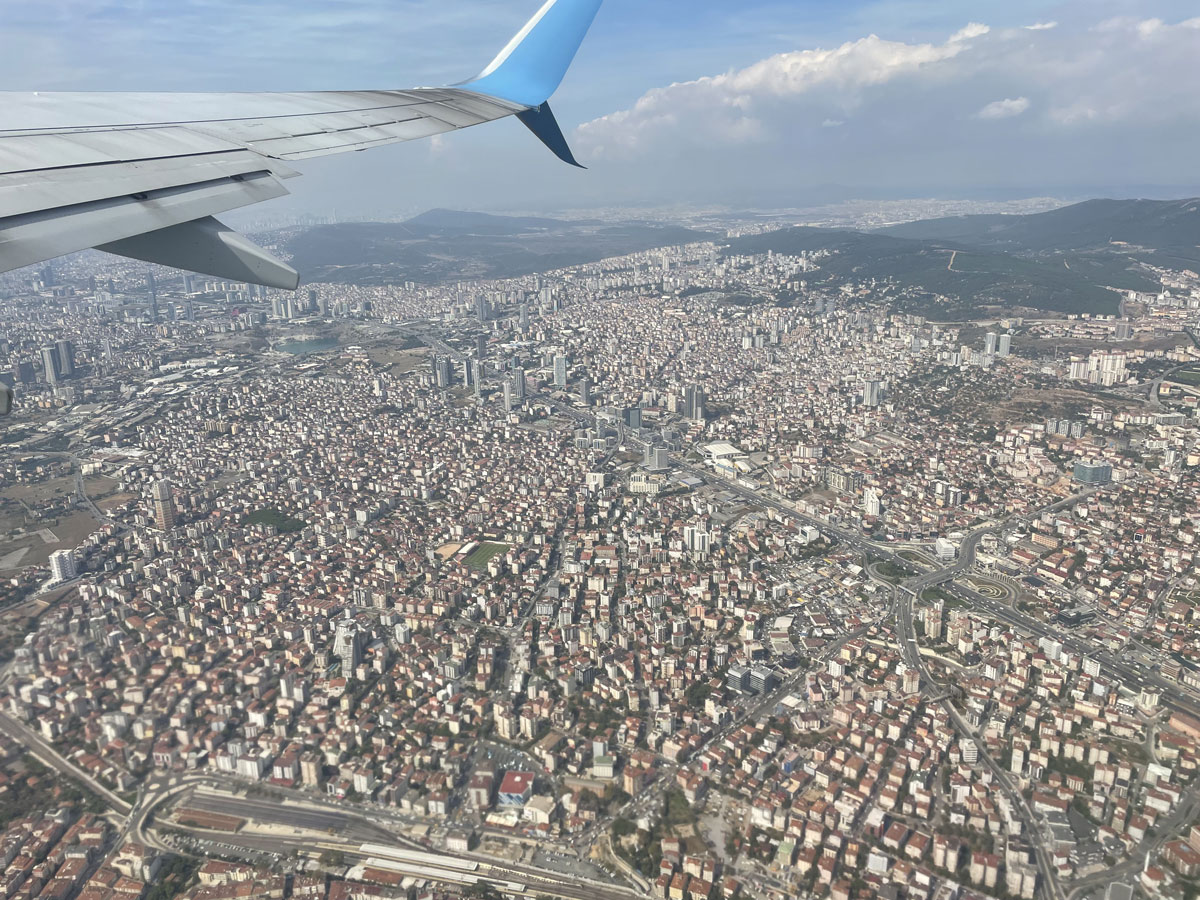Istanbul
Stambul! How much this sound merged for Russian heart!
Russia and Turkey are friends forever. Turkey is the most popular country for Russian tourists. Russian tourists are the most numerous tourists in Turkey. It’s just love till the grave!
The truth is, lazy Russians mainly go to Antalya to lie on the beach and throw fruits in their mouths. Most of them have never seen Istanbul even in the grave. And it’s a pity. Istanbul is a very decent city, although monstrously pop.
For an ordinary person, Istanbul is the best option to get acquainted with Eastern culture and have a good time at the same time. After all, not everyone can go to Syria or Iran. And in Istanbul, it’s all the same, but lighter. The calls of muezzins for prayer here do not bother anyone and do not oblige to anything, but are perceived as the city’s soundtrack.
A simple tourist wishing to see mosques will satisfy their interest in Istanbul. For example, in the center stands the absolutely bombastic Blue Mosque — one of the main ones in the city. Built in 1616. Here it is, hidden among the palms:
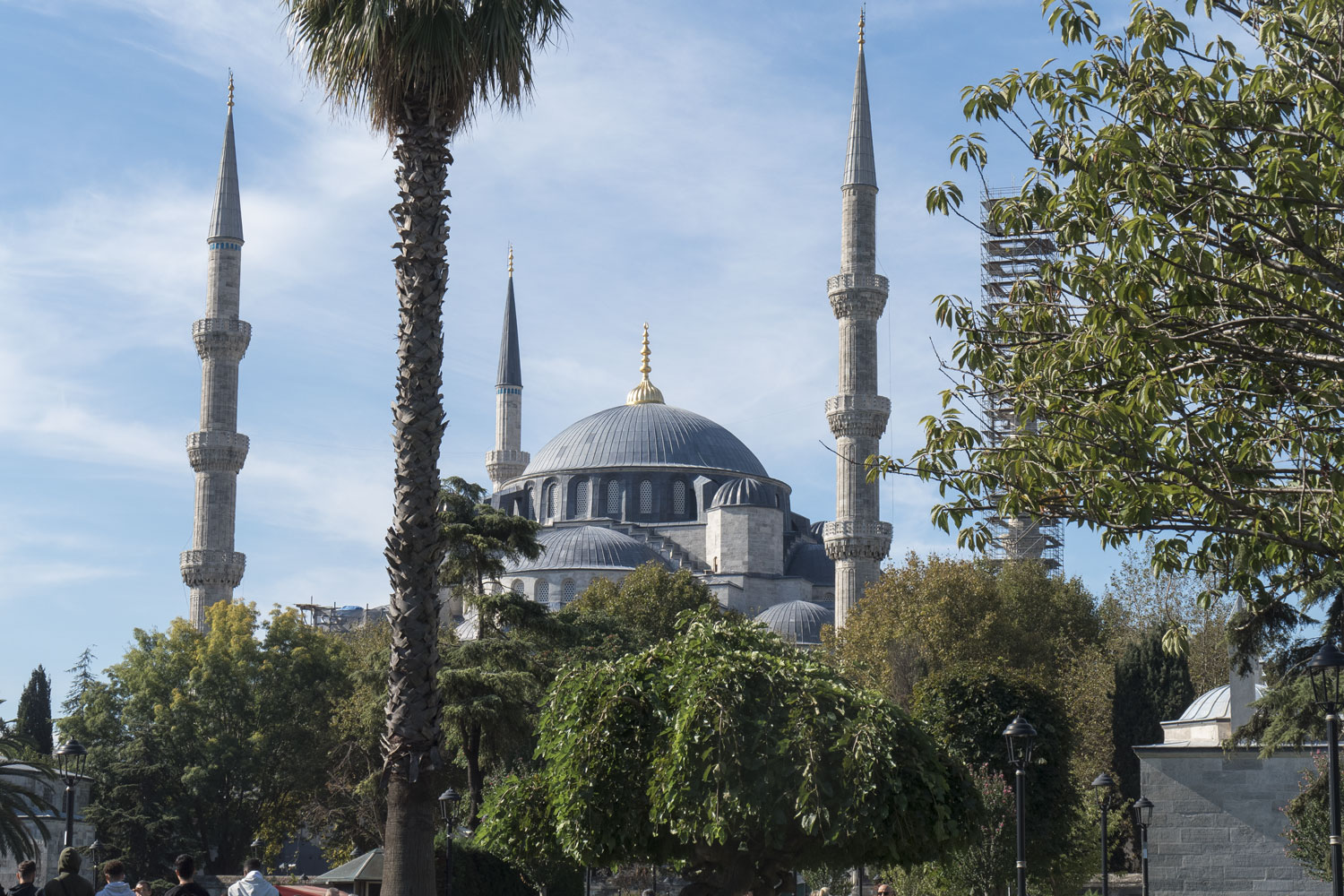
Right across from the Blue Mosque is the Hagia Sophia Mosque — the most scandalous temple in the world.
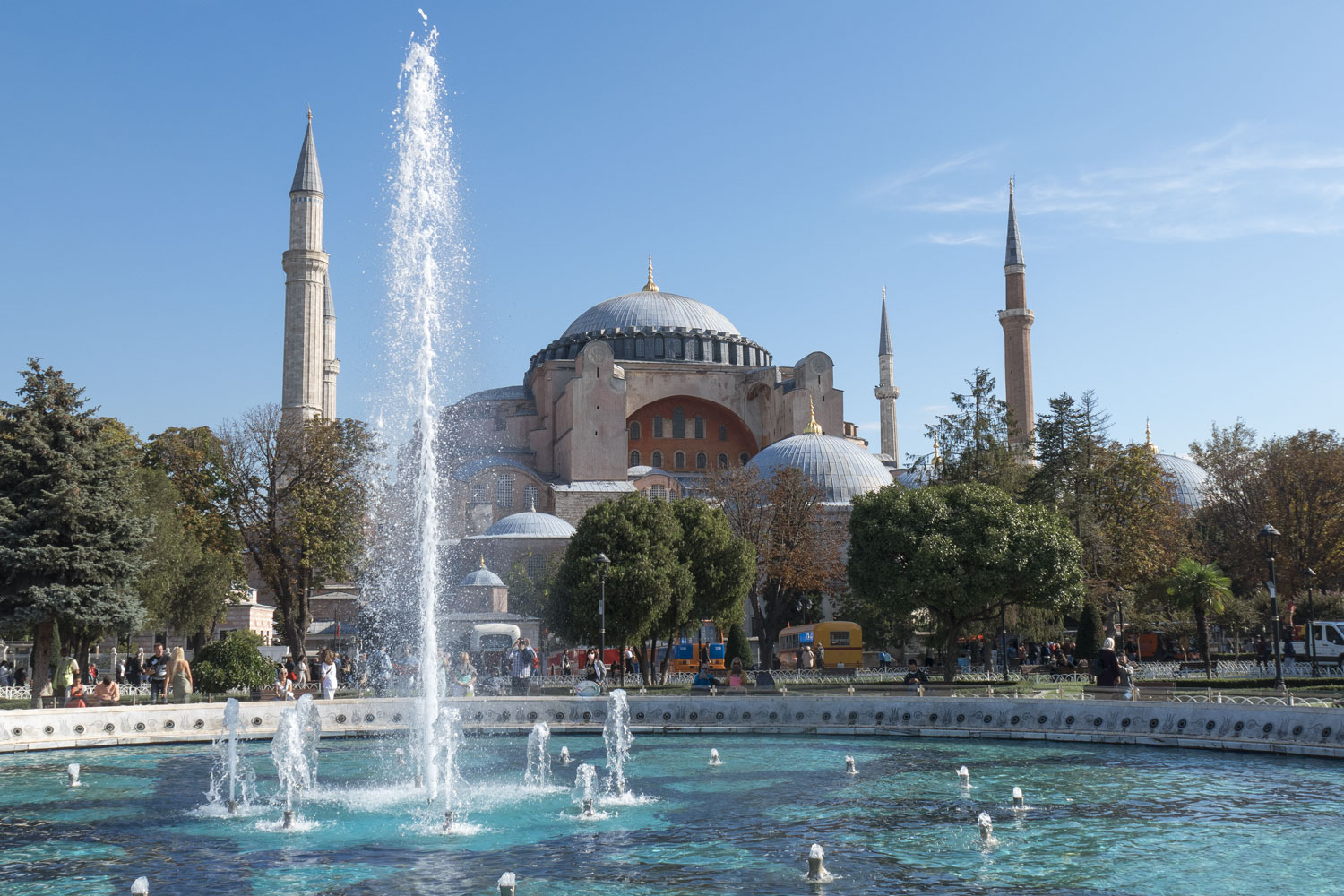
Hagia Sophia is an absolute ancient monument. It was built in 537 AD, and the previous temple stood on this site two hundred years before that.
Initially, this mosque was a Christian temple. The first version of the temple was built in 324 AD under the Roman Emperor Constantine the Great. At that time, the city was still called Byzantium, but six years later it would be renamed Constantinople after the reigning emperor.
The first temple stood for only 70 years, after which it burned down during a popular uprising. A new temple was built on its site, which lasted slightly longer — 120 years. This happened under Emperor Justinian, who is known for taking over the Roman Empire with money and leaving it with new buildings.
The scale of construction under Justinian was such that a six-volume collection “On Buildings” had to be written. With unrestrained passion for construction, as well as his endless reforms, transformations, and wars, Justinian emptied the entire Roman treasury and left the army completely exhausted.
I am not capable of assessing all of Justinian’s architectural achievements, but with the new building for Hagia Sophia, he hit the mark. The temple turned out to be monstrous. It was necessary to buy up adjacent lands and hire the best architects in Byzantium for its construction. The temple was built for five years by the hands of ten thousand workers.
At first, the temple was Catholic because there was no Orthodoxy in sight. However, in 1054 something terrible happened. The priests could not decide whether it was permissible to add yeast to the Easter bread. Some priests argued that the bread should be prepared with leaven, while others insisted that it must be unleavened.
Leaven to the breadFuel to the fire was added by political disagreements, and as a result, the argument became so heated that the priests excommunicated each other, and the Christian Church tore at the seam out of laughter and divided into Orthodox (for yeast) and Catholic (against yeast).
This split, which is called “The Great Schism”, occurred precisely here in the Hagia Sophia temple.
The reader may ask: how did a Christian temple become a Muslim mosque? It’s actually quite simple! The Turks came to Constantinople, who two hundred years earlier were just a horde of incomprehensible tribes in eastern Turkey, and added four minarets to the temple. Well, that’s it, what else to say?
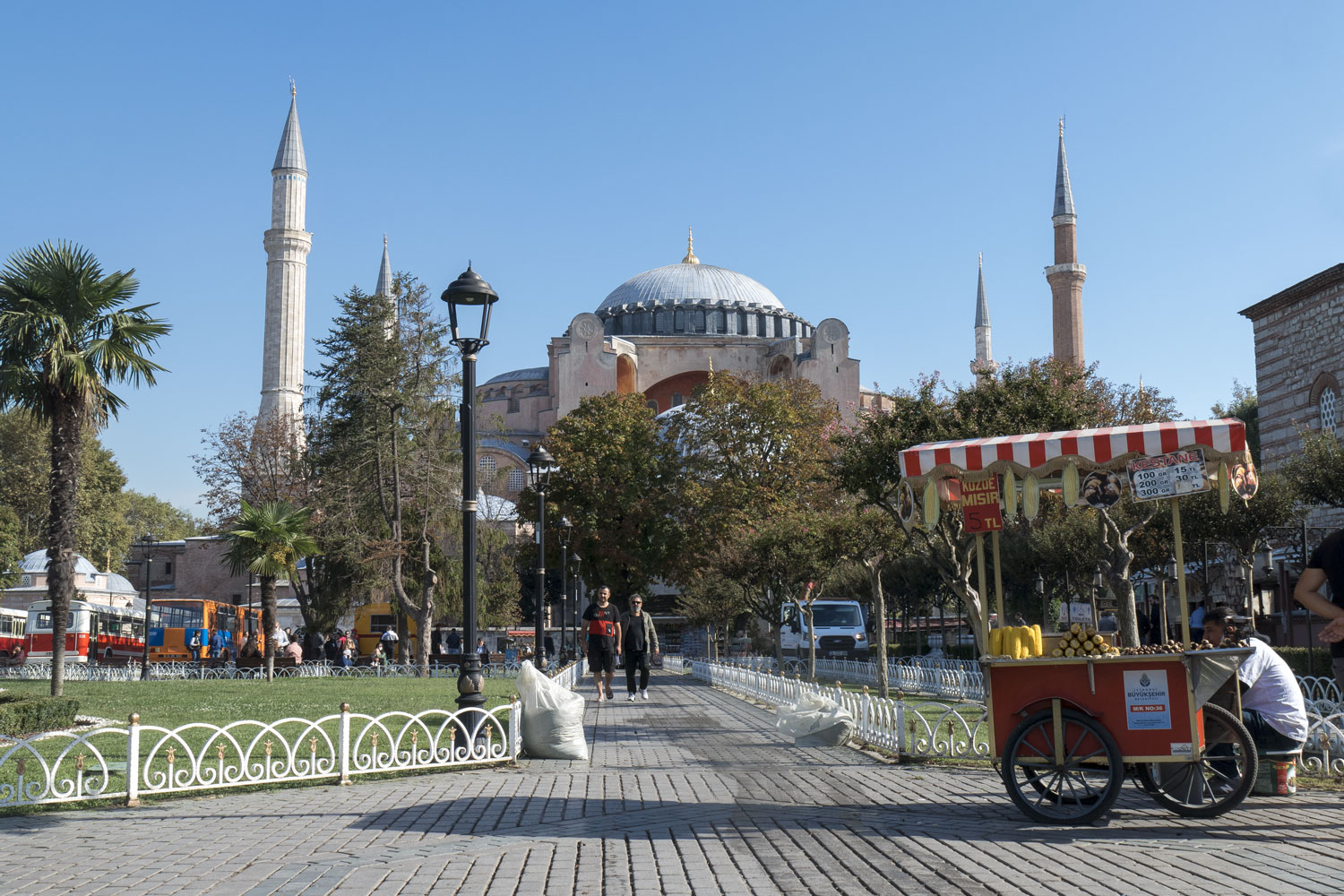
By the way, the minarets strongly resemble winged missiles. Perhaps we don’t know something about mosques.
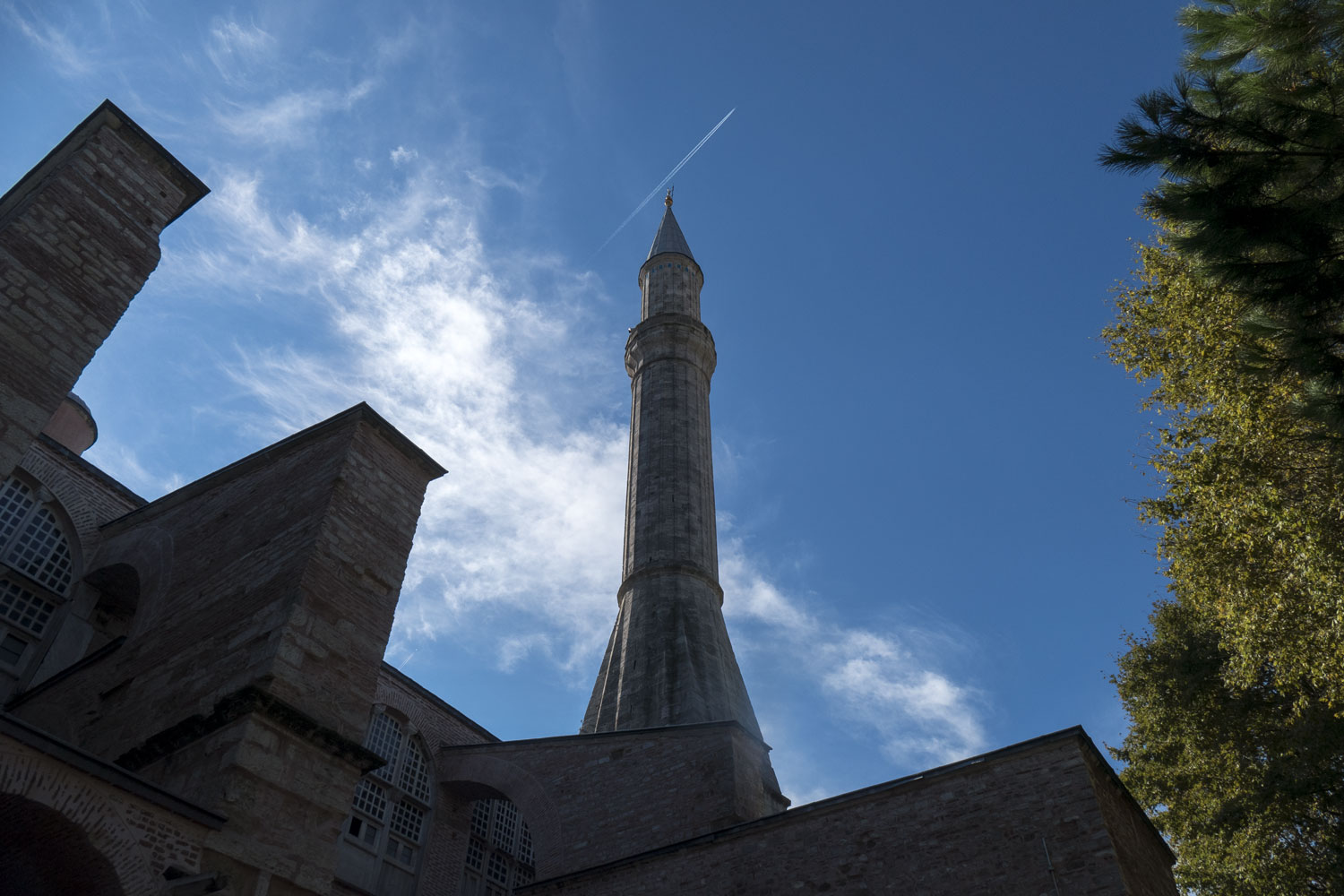
On the walls of the mosque, you can see, apparently, arches of the former temple. I’m not sure. There are so many secret features and nuances in it that you need to read a whole book to figure it all out.
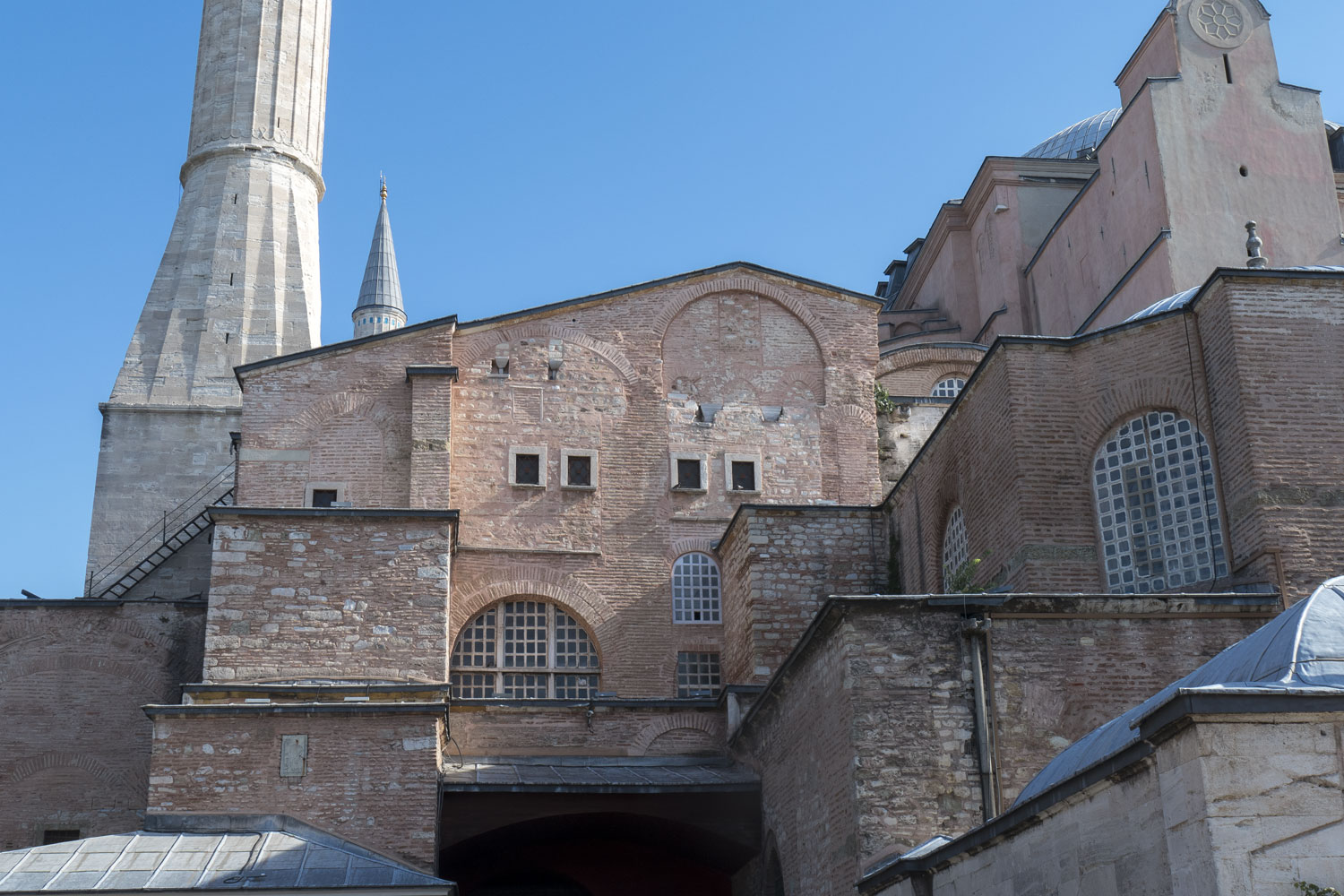
But the coolest thing awaits the traveler inside. At the entrance, there is a mosaic with Jesus Christ. A mosaic with Jesus Christ! At the entrance to the mosque!
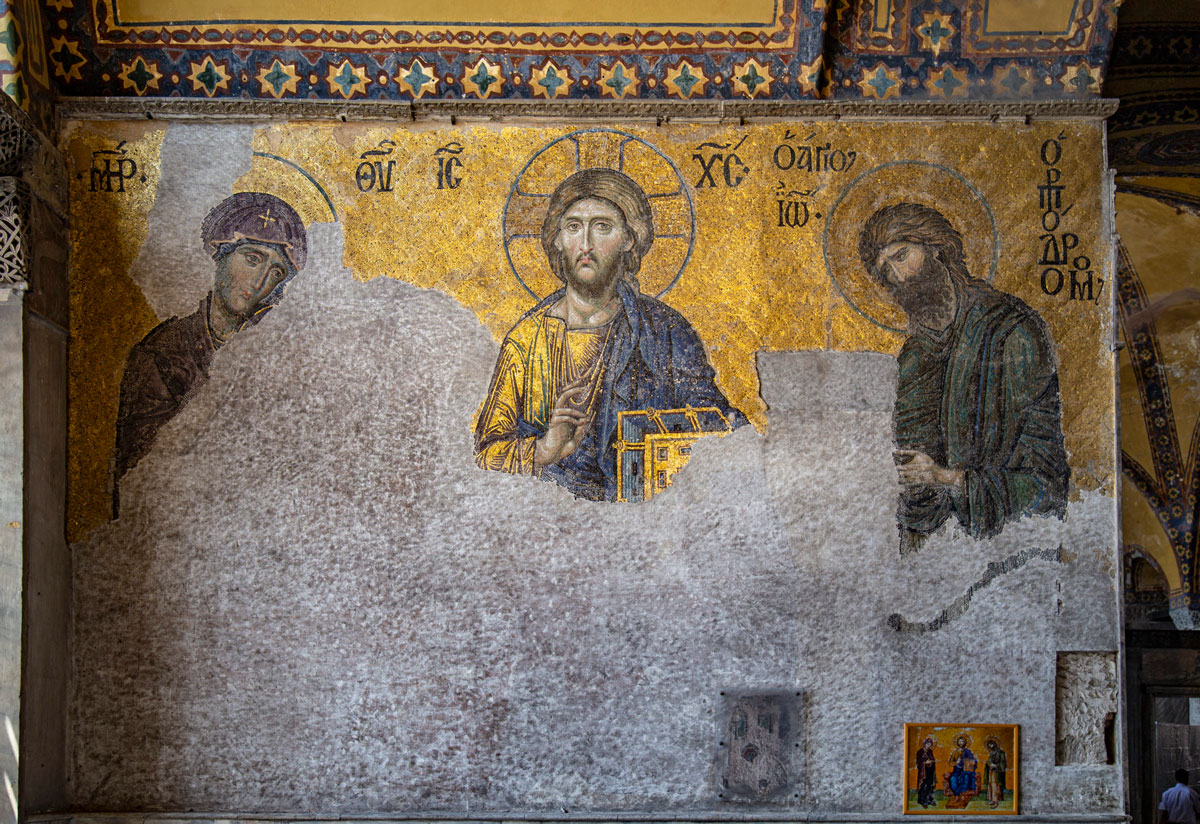
From another entrance, above the doors, there is a mosaic with the Virgin Mary. By the way, on the left is depicted Emperor Justinian with the new temple, and on the right is Emperor Constantine with the old one. The mosaic was laid in the 10th century.
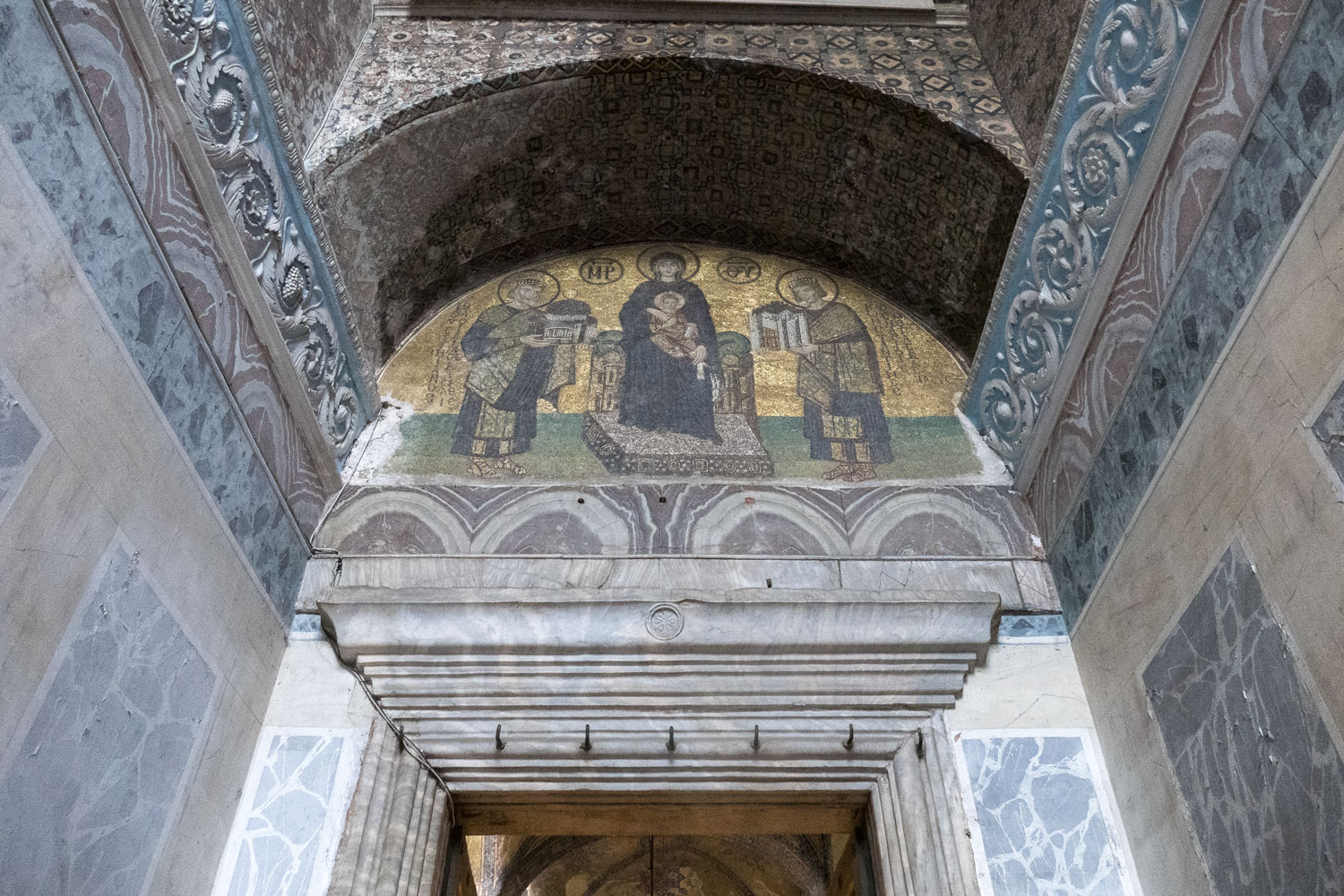
What the hell is going on here? In Islam, it’s forbidden to depict not only saints but people in general. Images are considered idols. It’s absolutely unthinkable to hang icons in mosques! Anyone who prays towards icons is considered a pagan and is instantly expelled from Islam.
So, of course, there were no mosaics during the Ottoman Empire in Hagia Sophia. After the conquest of Constantinople, the Turks simply covered them with plaster. Fortunately, they didn’t have enough sense to destroy them completely, so during the restoration in the 19th century, the plaster was accidentally removed and icons were discovered underneath. A hundred years later, Kemal Ataturk came to power and turned Turkey into a secular state, converting the mosque into a museum.
Nowadays, Hagia Sophia is an absolutely unique phenomenon — a half-mosque and half-church. On the one hand, Islamic calligraphy is hanging everywhere inside and women stroll around wearing hijabs.
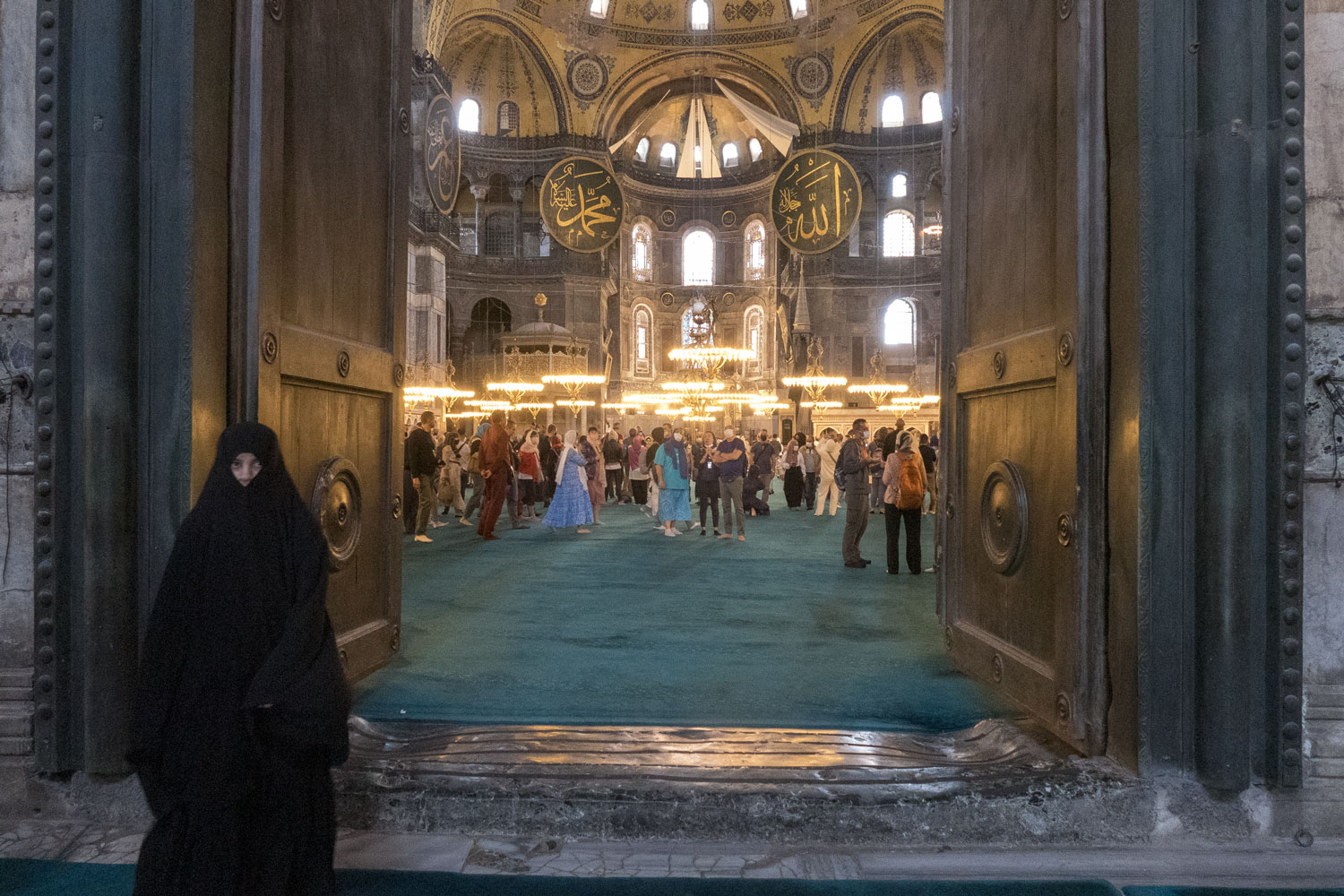
On the other hand, the vaults reveal depictions of Christian saints and angels.
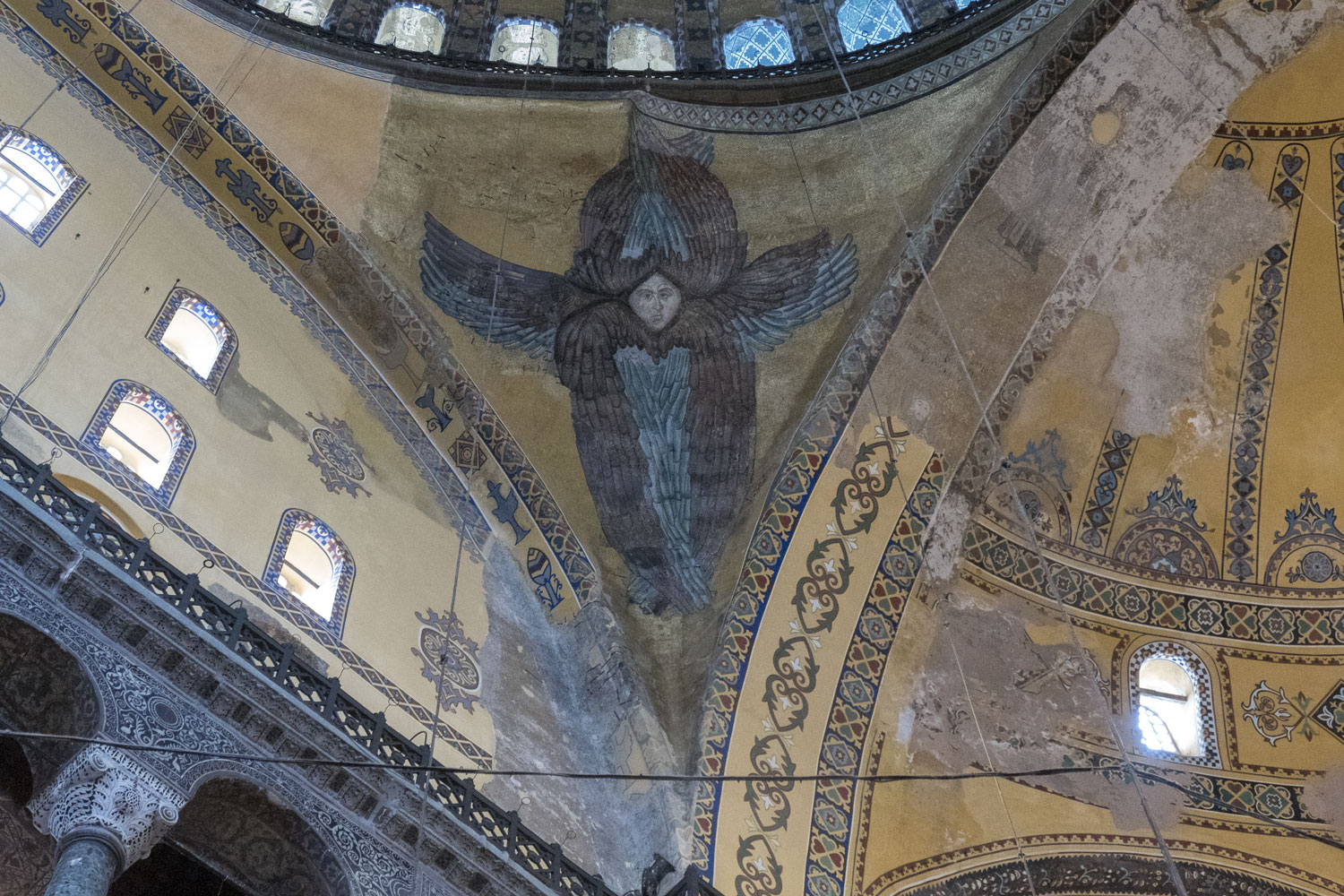
Absolutely stunning place.
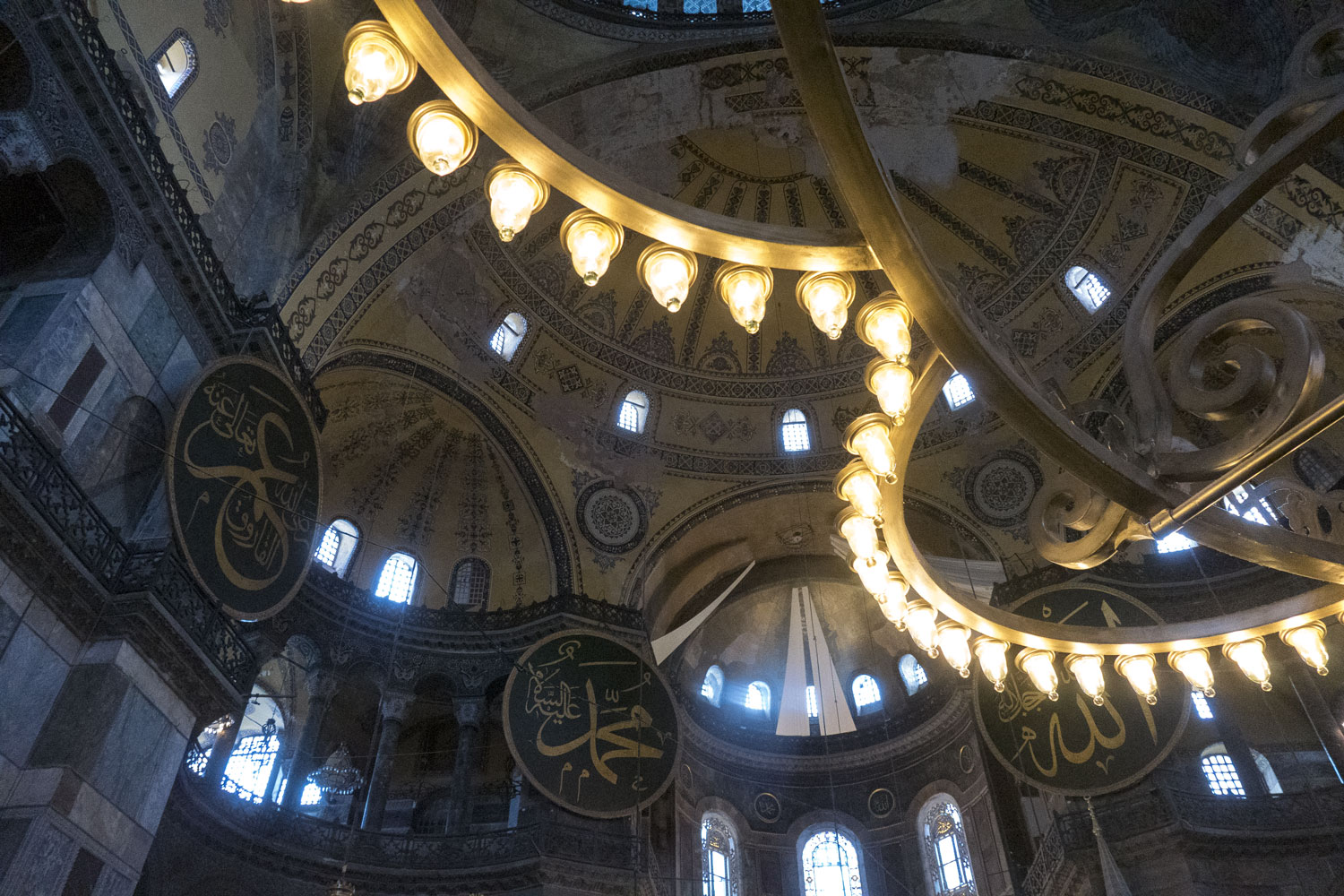
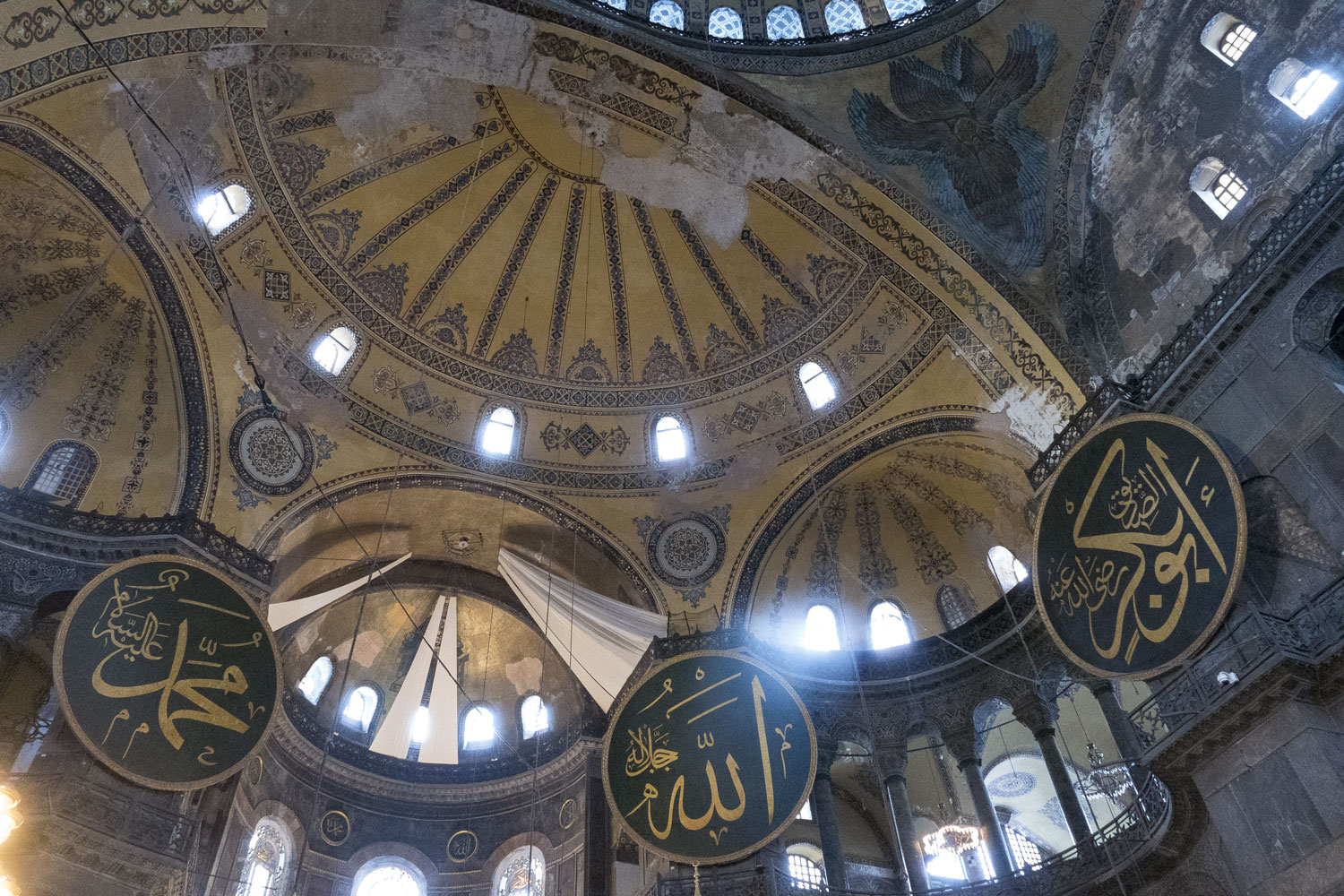
I thought it was impossible, usually stunning places have to be specifically sought out, but here in the center of a tourist city stands such a gem.
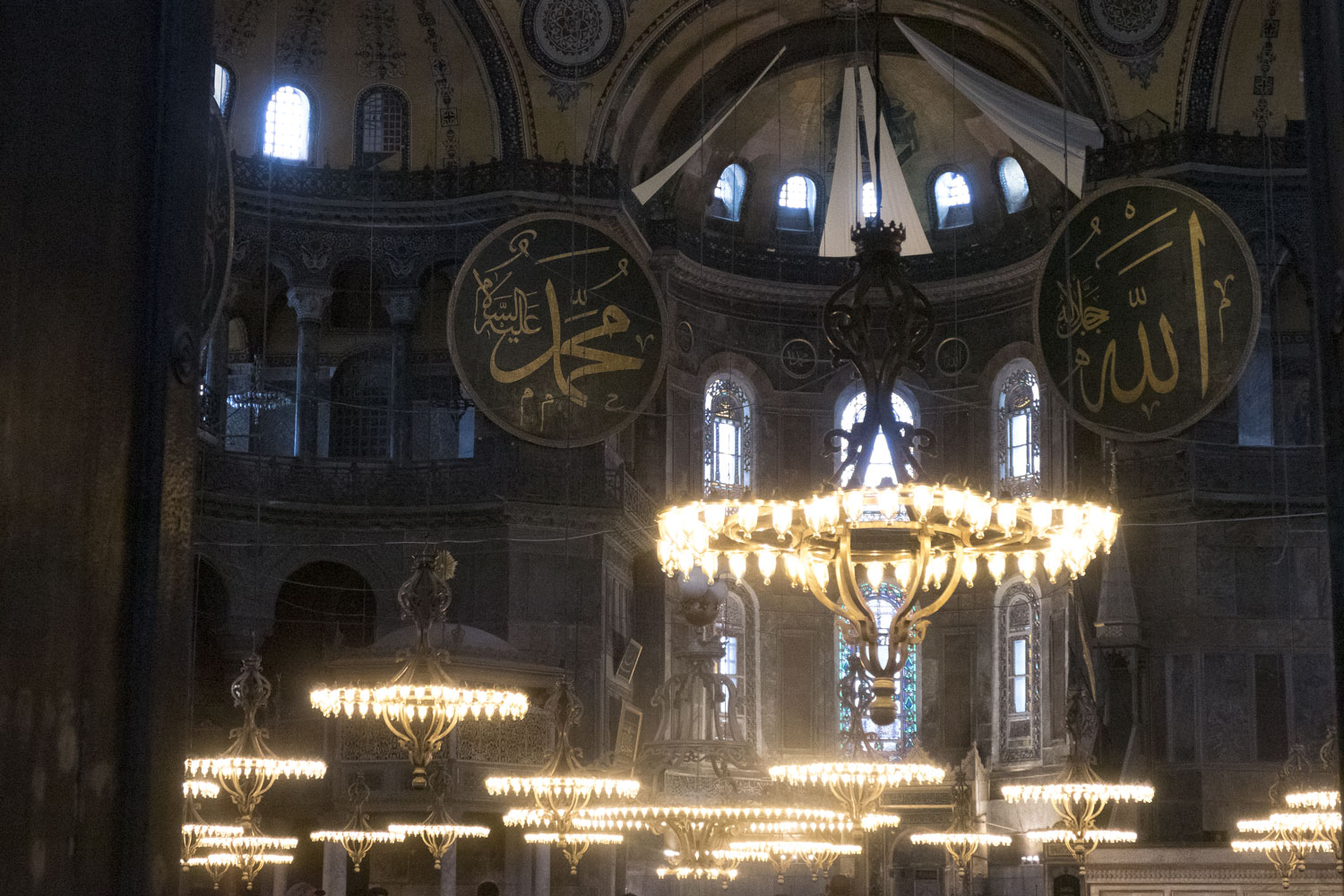
The only downside is that in 2014, the crazy Erdogan came to power, who in 2020 cancelled Ataturk’s decree and returned Hagia Sophia to its status as a mosque.
The world was shaken. Erdogan’s decision sparked a wave of criticism, in which even the Russian Orthodox Church took part. Erdogan did not react, and Muslims were allowed to pray in the former Hagia Sophia museum. But what is worse — the Turkish authorities covered the depictions of the Mother of God in the central dome of the church with canvas sails. Prior to this, the dome looked like this:
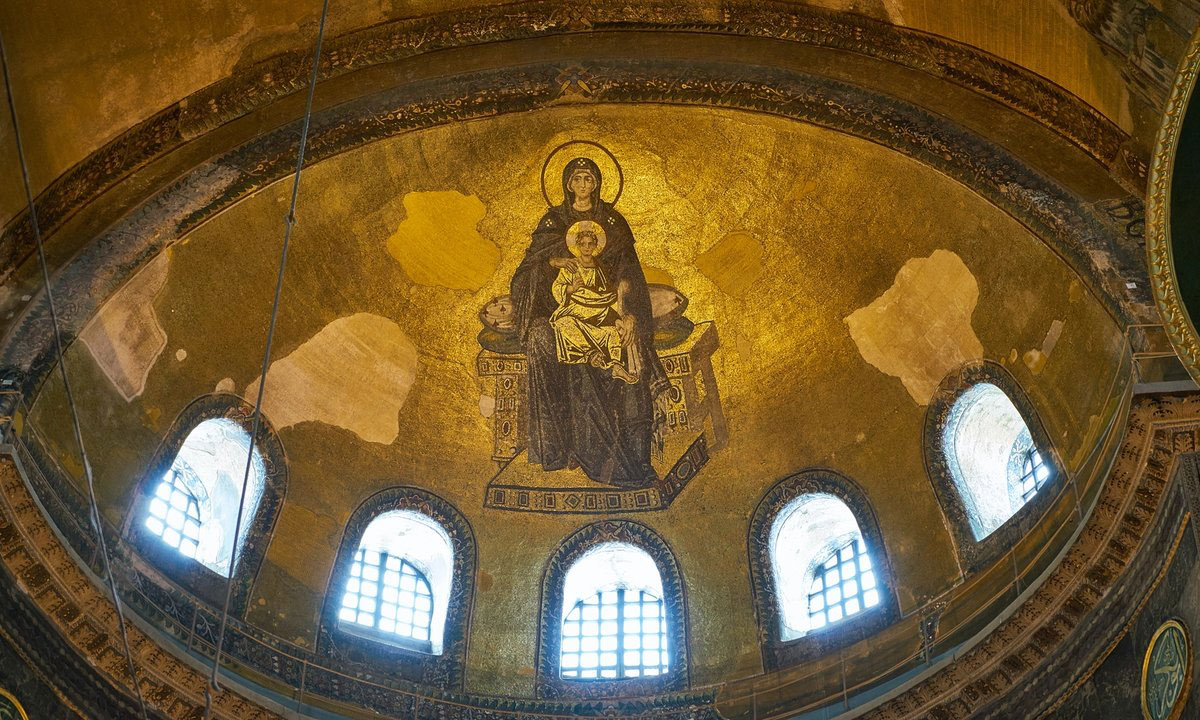
Now it looks like this:
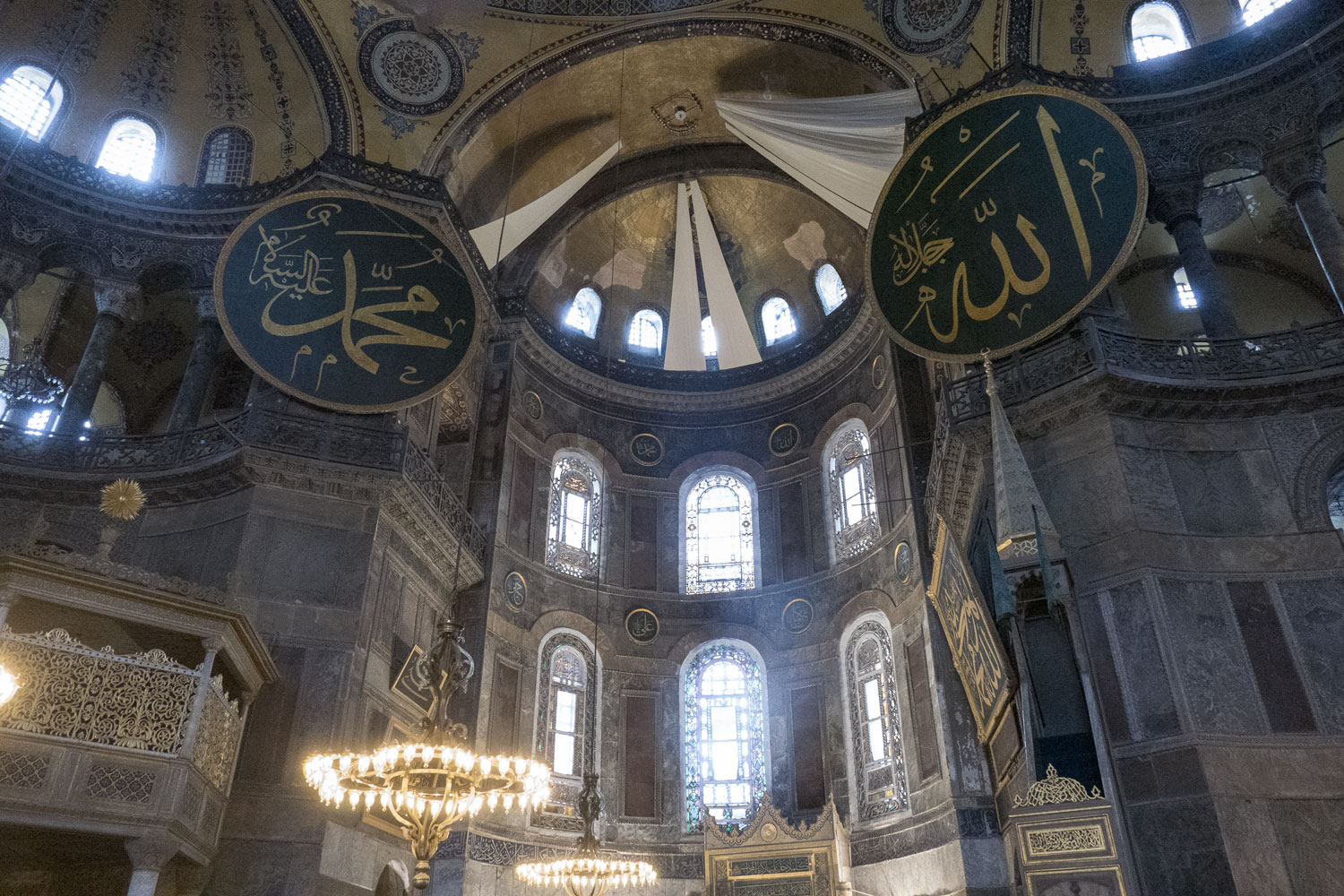
It’s amazing that a cursed religion turned out to be alive in the 21st century and has begun its campaign against human civilization again.
There are a huge number of mosques in Istanbul, they are literally everywhere. Most of the mosques are built according to the model of Hagia Sophia, which became the prototype of the Ottoman style in Islam, and therefore they are indistinguishable from each other.
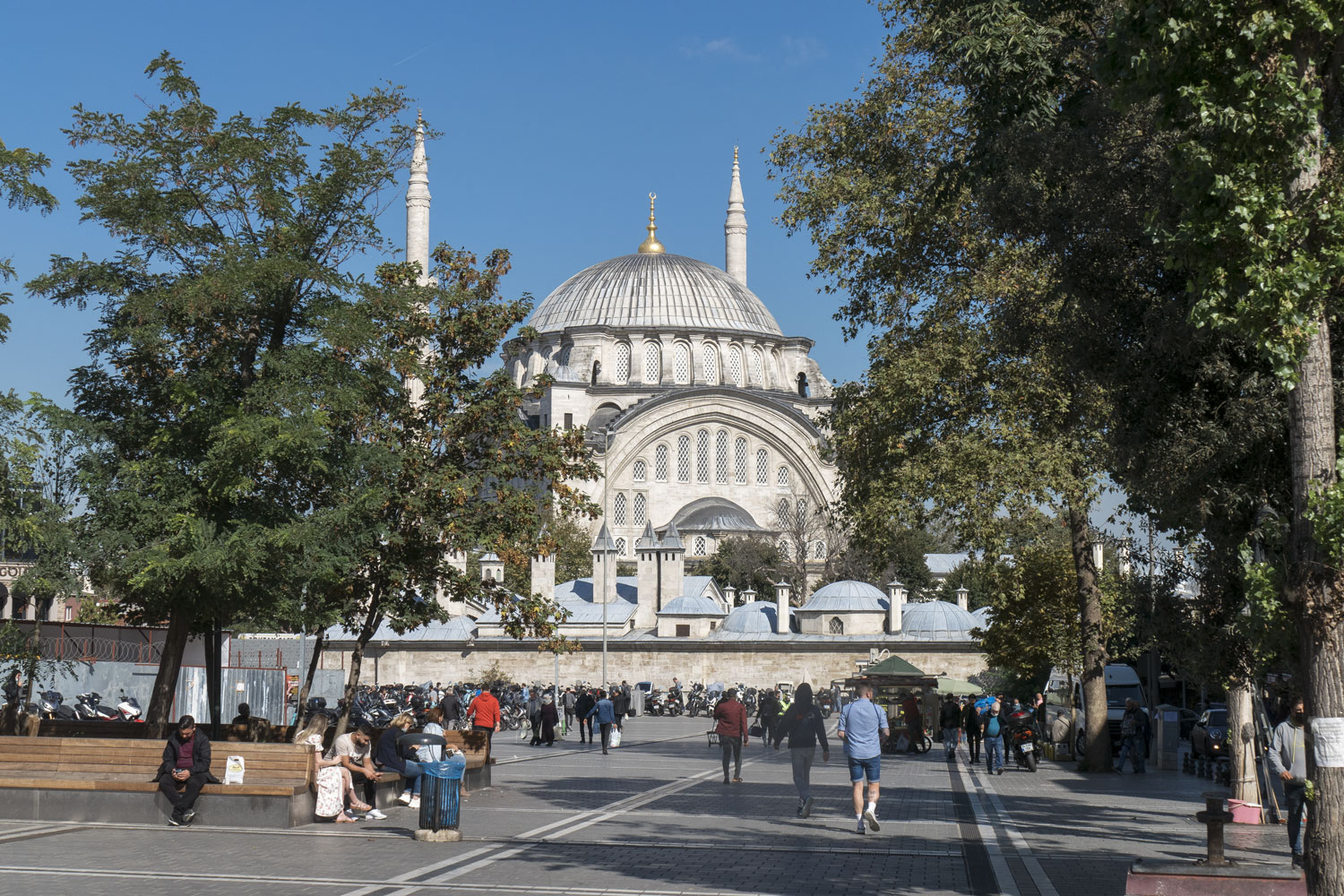
There are no fewer markets in Turkey than there are mosques. Istanbul gives an ordinary tourist a great opportunity to see the eastern bazaar and not go crazy from the crowds.
The Istanbul Grand Bazaar is a very spacious, covered and beautiful market. Not inferior to markets in Morocco or Iran.
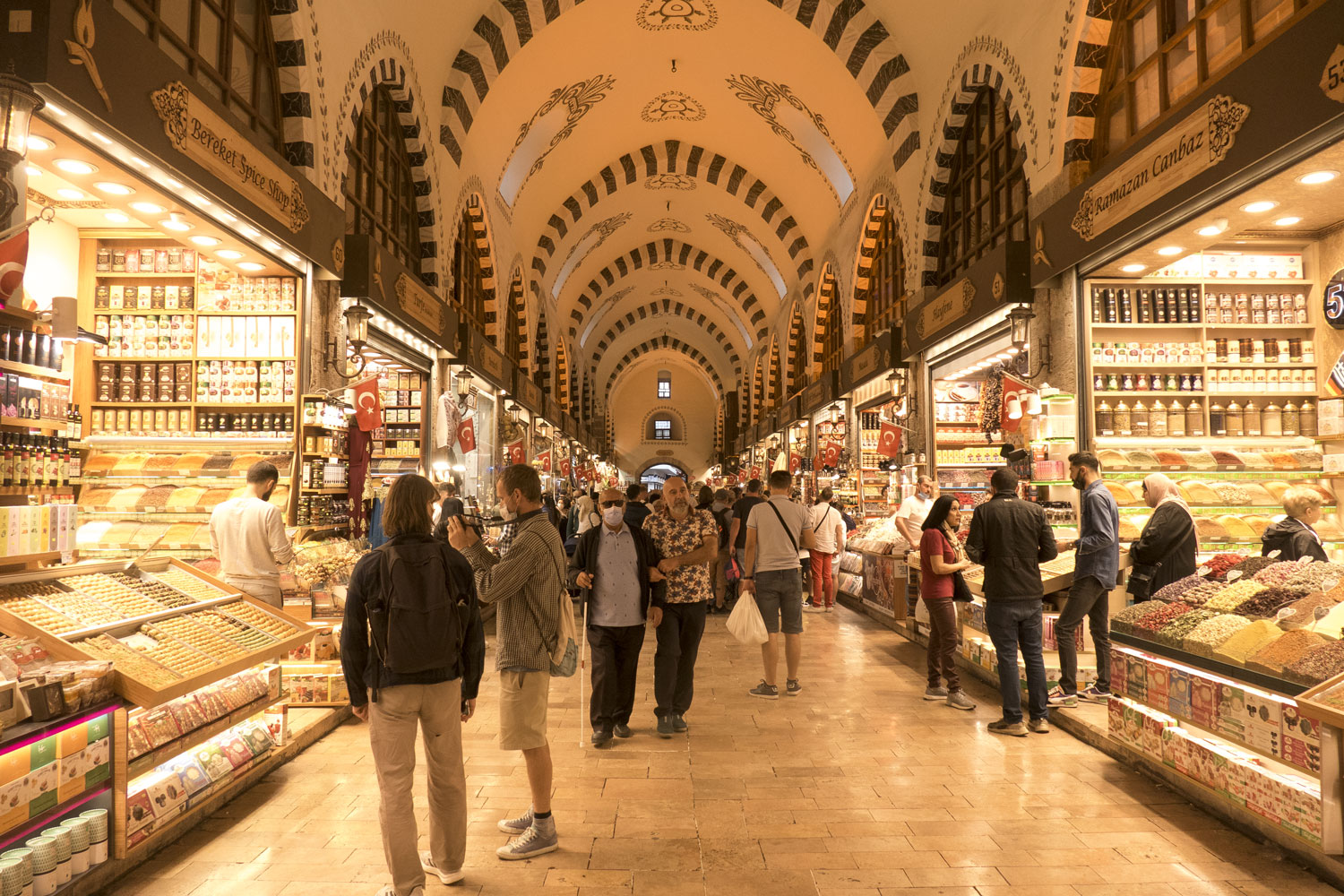
It seems like the vendors speak all the languages in the world. This is also suitable for an ordinary tourist: it’s easier to negotiate something at the Grand Bazaar, whether they are Chinese, British, or Russian.
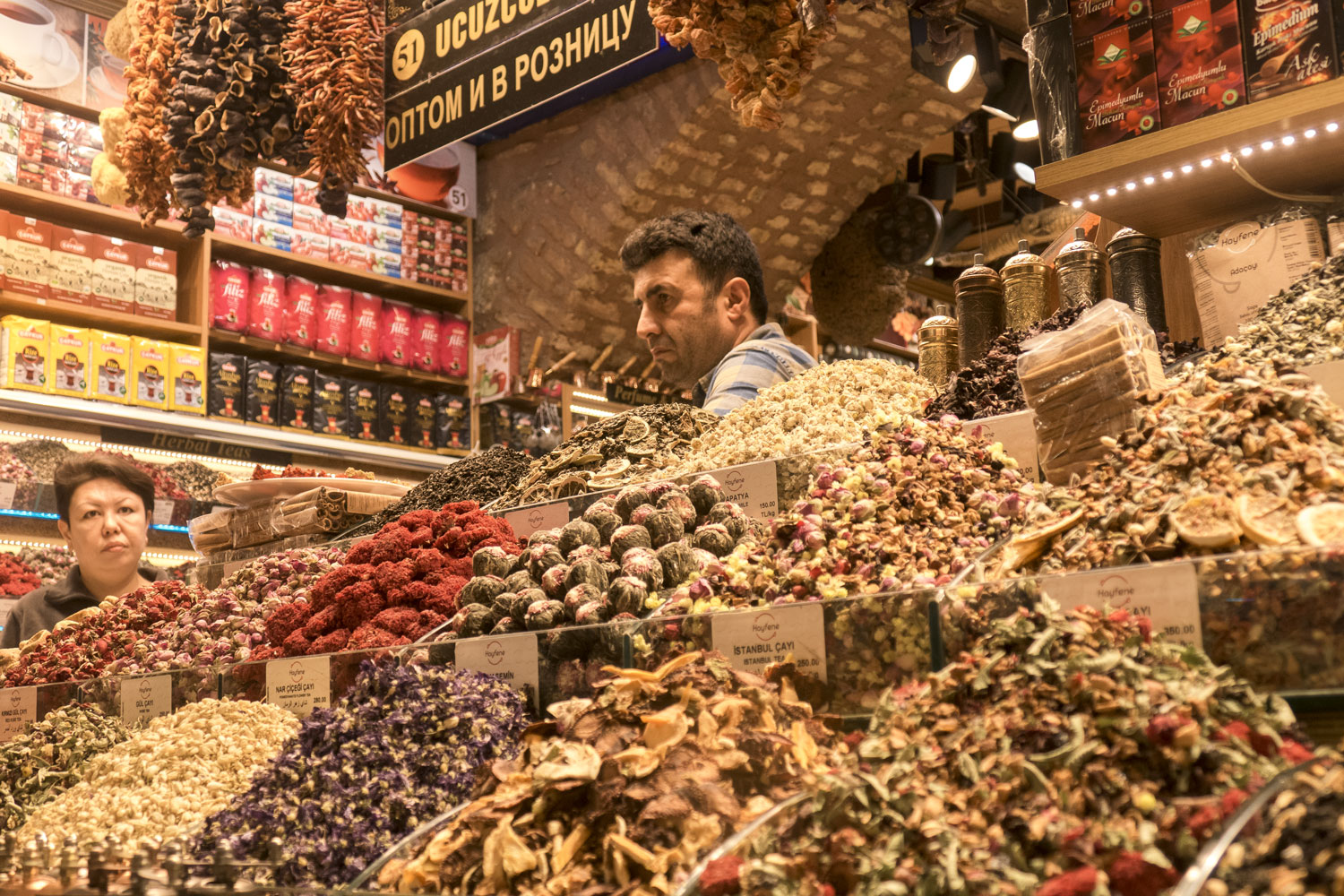
The most popular commodity is sweets.
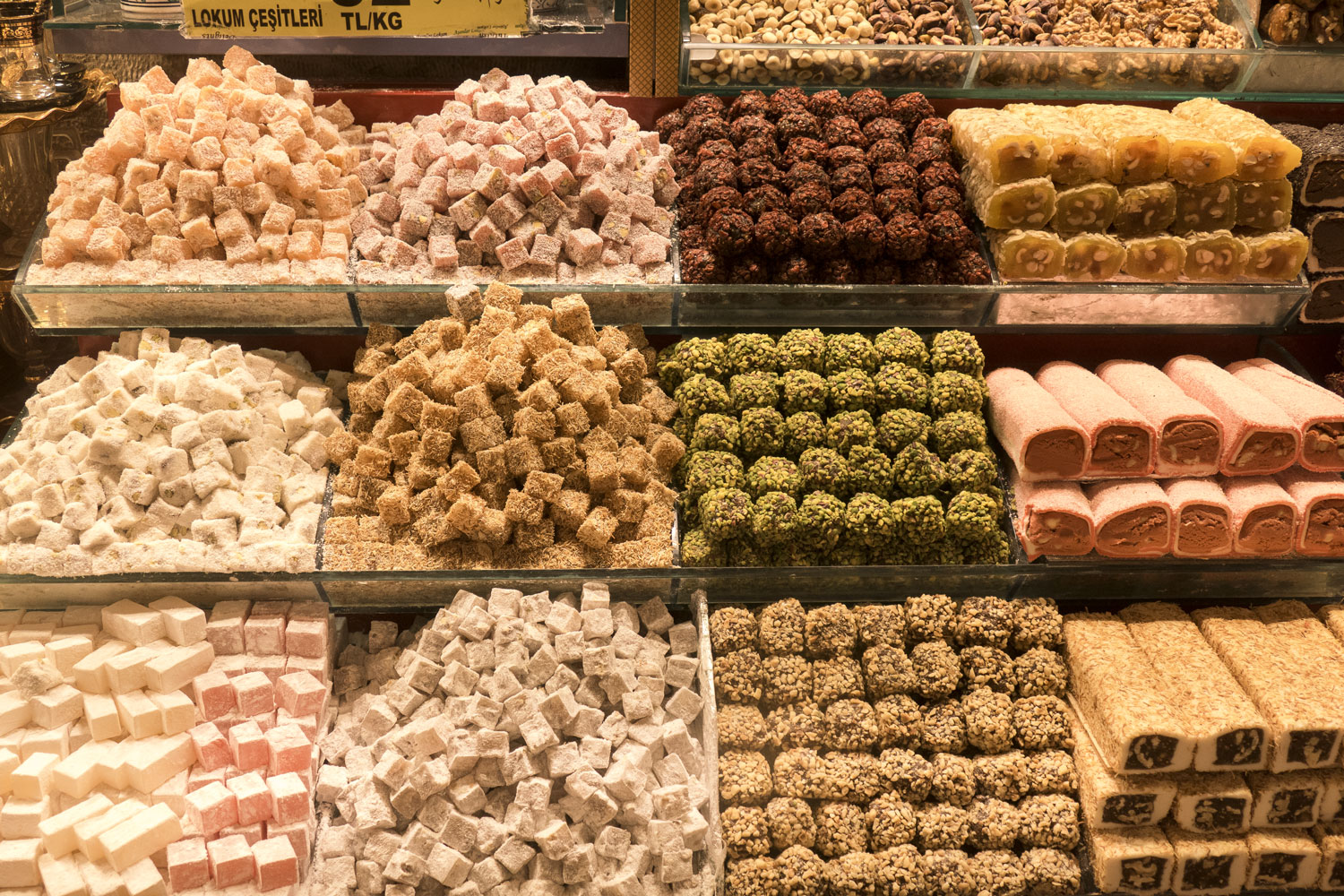
Every other stall sells spices, tea, dried fruits, peppermint, Iranian saffron, and dates. The smells can make you dizzy immediately.
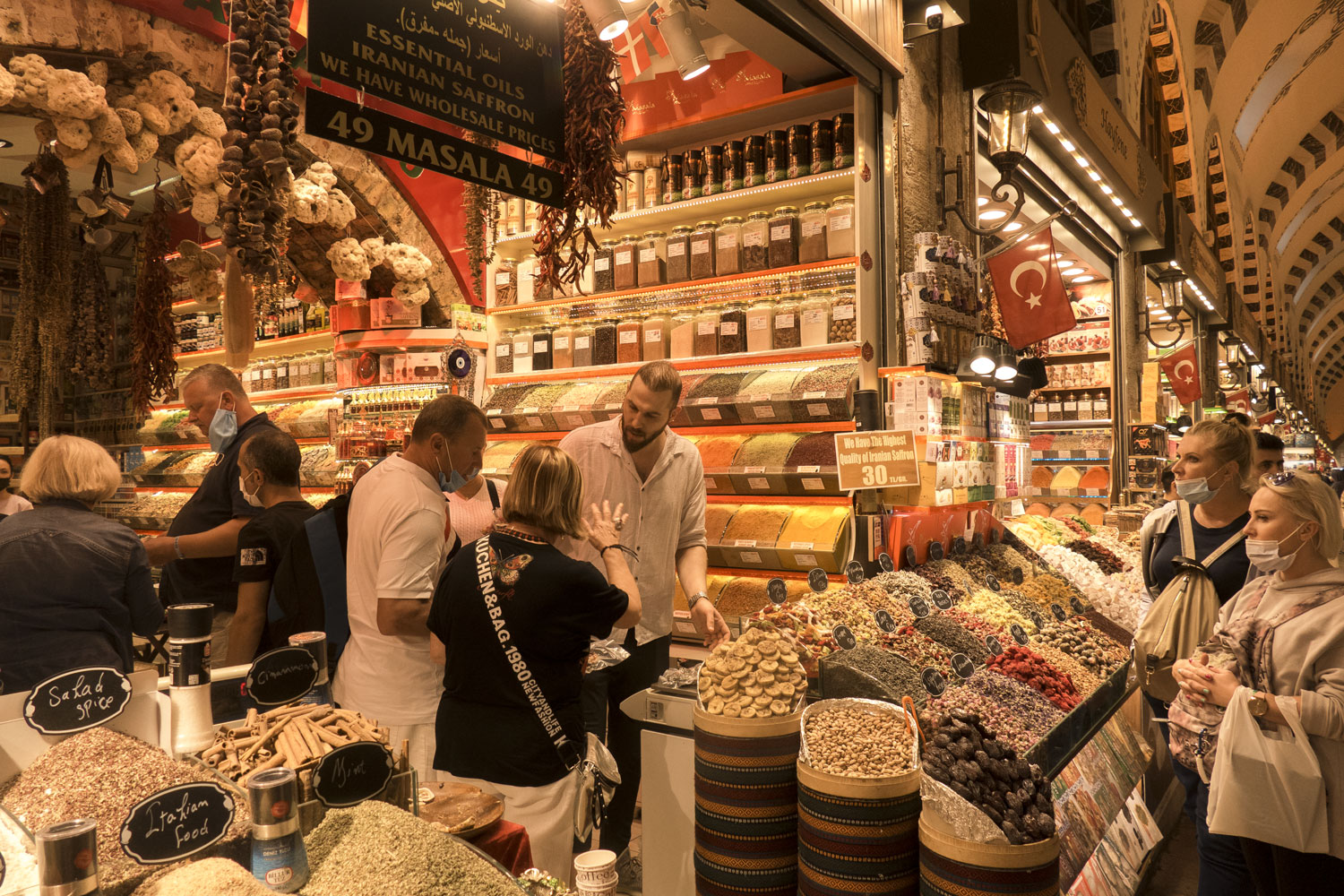
The Grand Bazaar is bursting with all kinds of junk. Here sold: plates with intricate ornamentation, decorative lamps and light fixtures, various vessels of different shapes and purposes, vases, cups, plates, gilded forks and spoons, coffee makers, Turkish teapots, and hookahs.
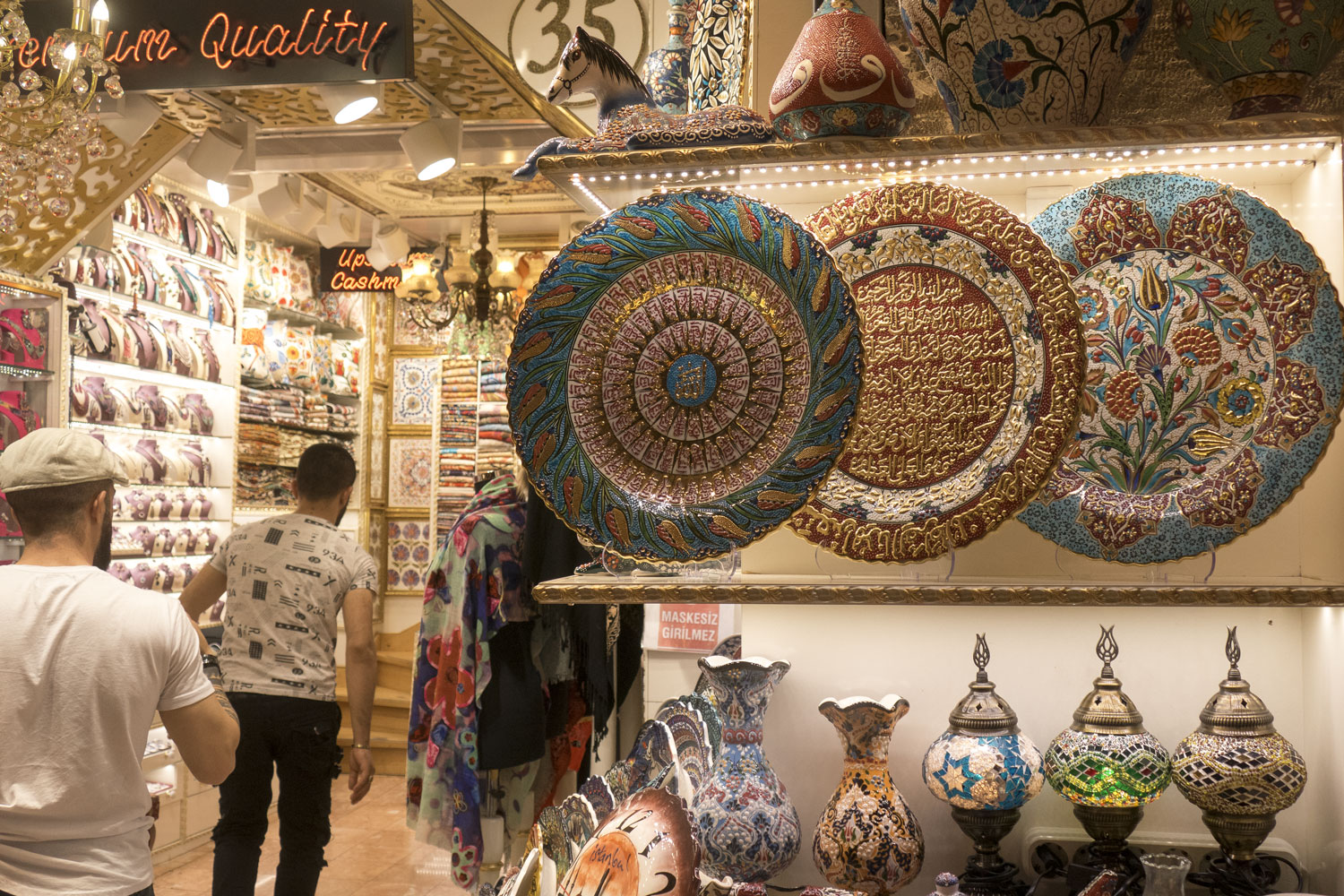
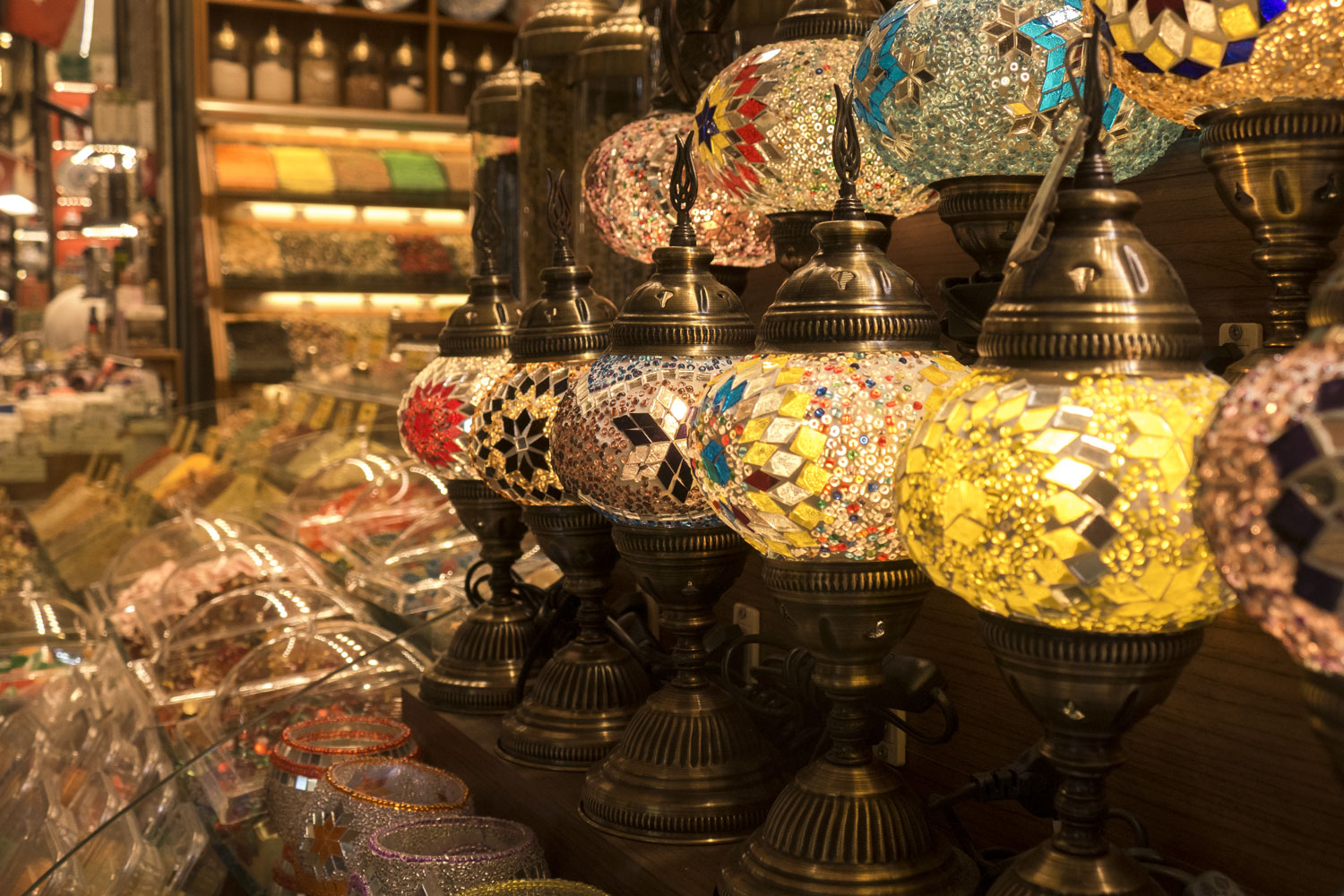
Is there really anyone who buys all this junk? The market itself answers: yes. Trade in this place has been going on for a thousand years. They began building the Grand Bazaar in the 15th century, and it grew for many centuries until it stopped at its current size somewhere in the mid-18th century.
Some shops have been continuously operating for several hundred years. This business is passed down from father to son.
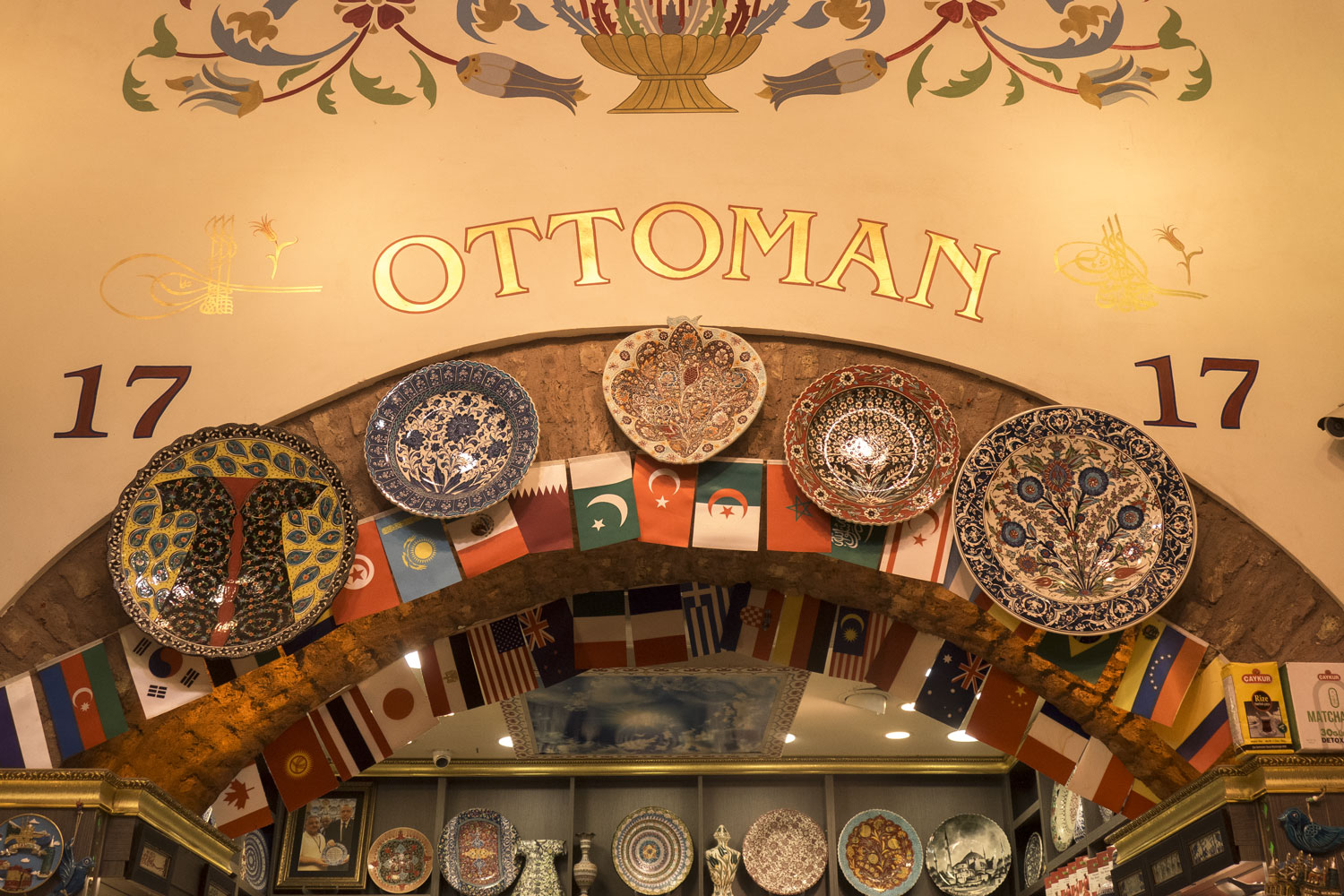
But the best part is that there are so many tourists in Istanbul that everyone has long stopped caring about taking photos. You can take pictures of absolutely everything, and no one will say a word. In the markets of Morocco, not every seller allows you to take close-up shots of their goods.
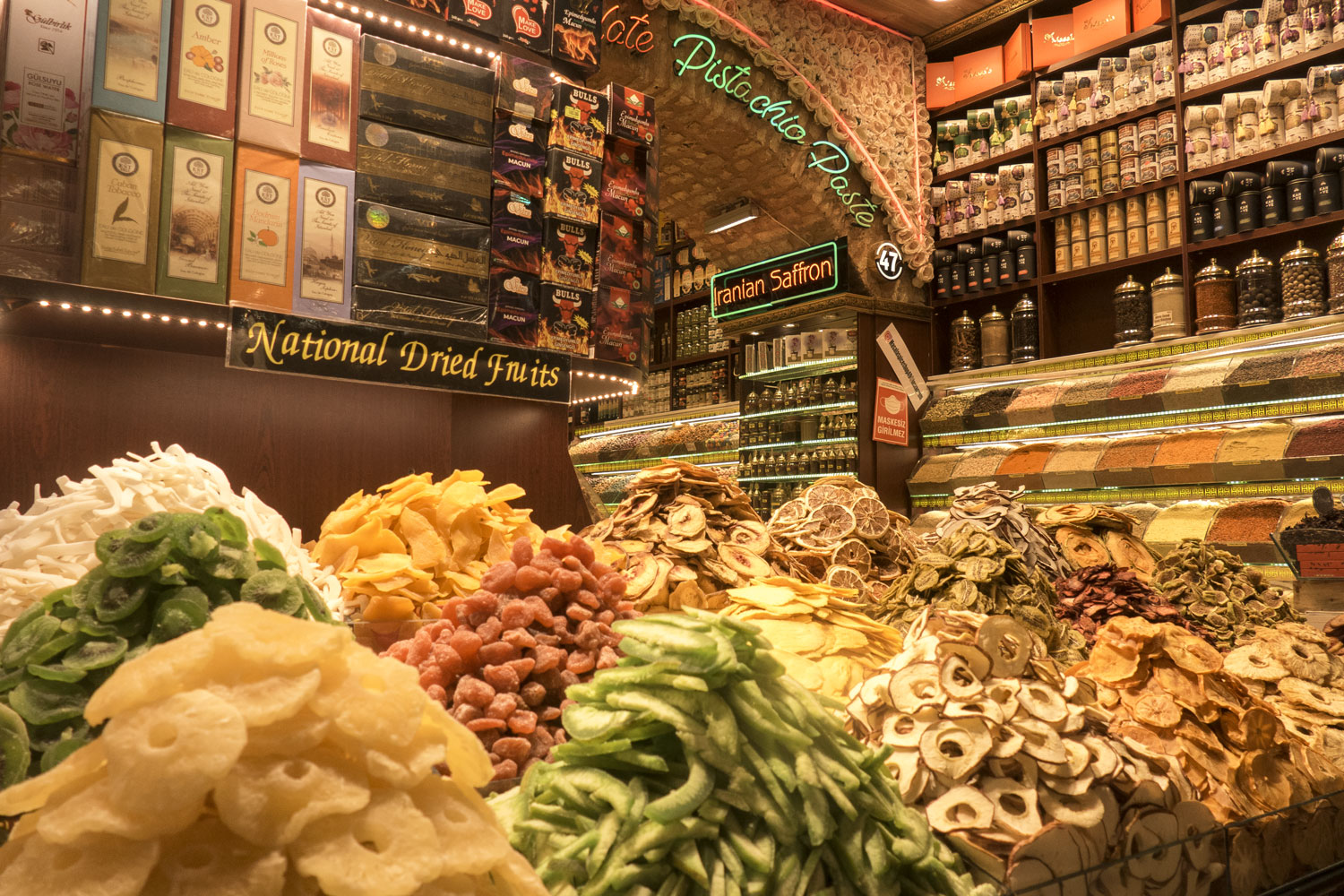
Trade is not only conducted in the bazaar, but also on the streets of Istanbul, which themselves resemble a bazaar and are filled with trading points. Stalls are set up in rows or stand alone, depending on the area.
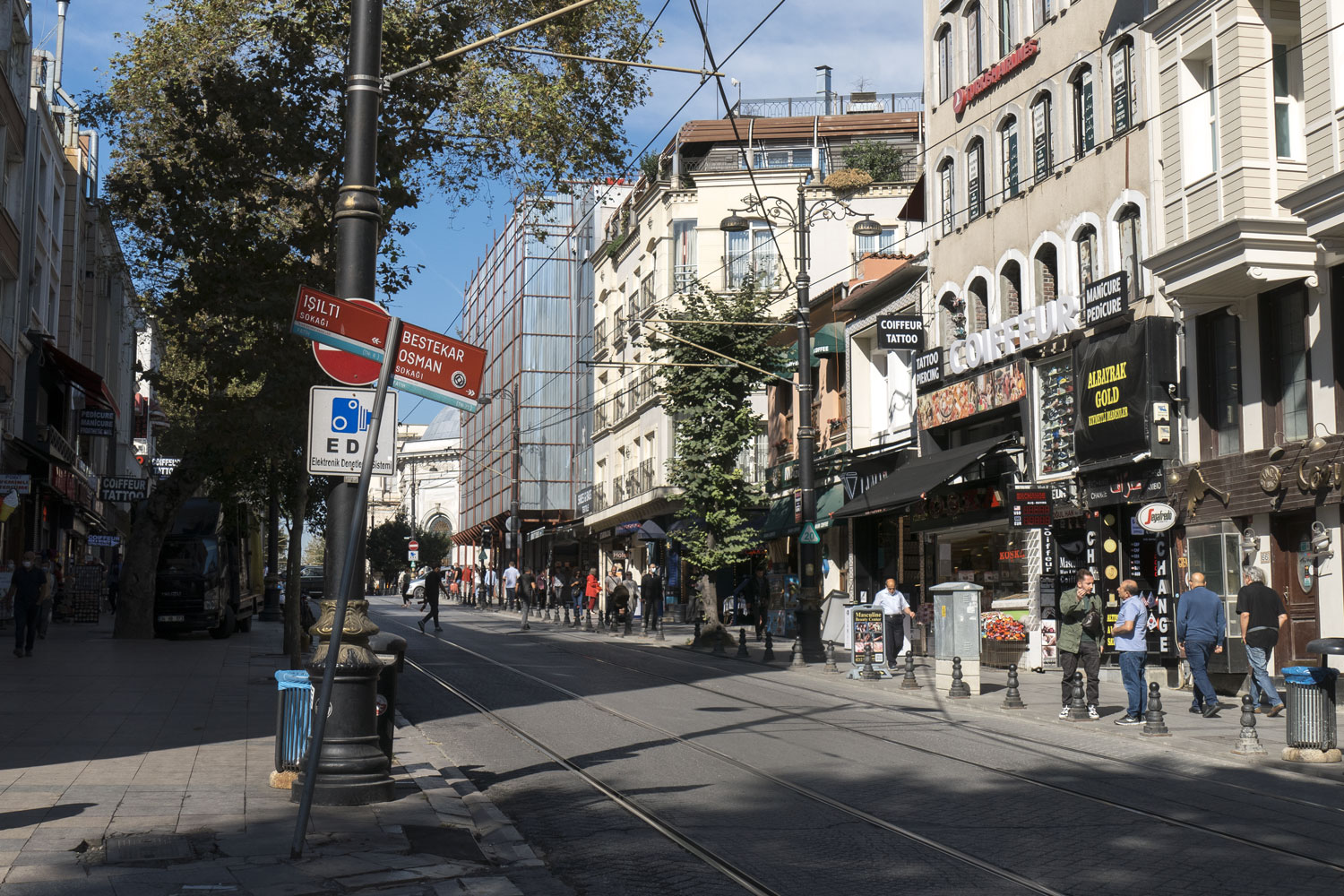
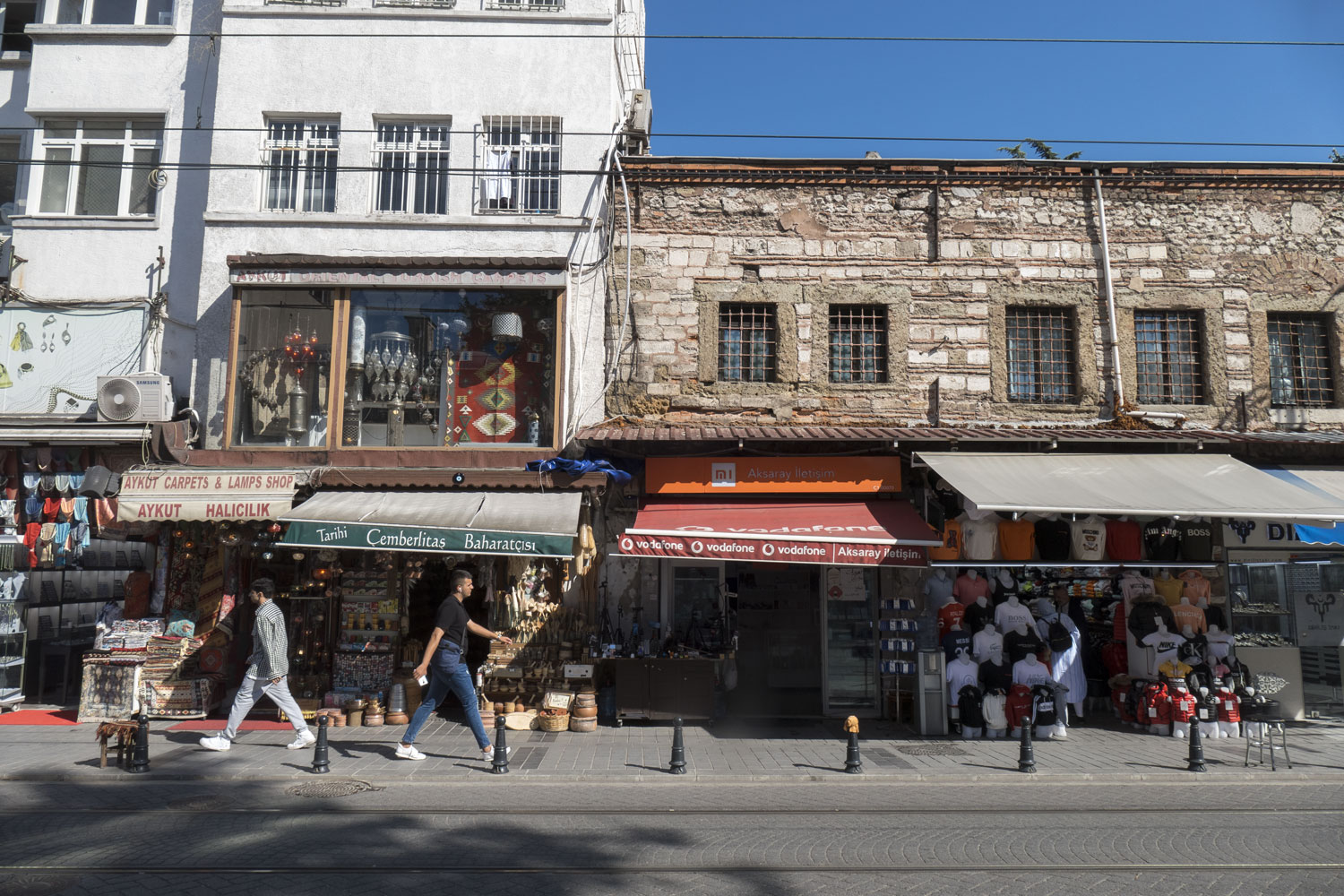
The center of Istanbul is quite compact, despite the fact that the city itself is absolutely gigantic — twice the size of Moscow.
Once in the city center, next to the Blue Mosque, there was an ancient Hippodrome, which began construction as early as 200 AD. Competitions were held at the Hippodrome — chariot races. The chariots raced in a circle on a large square. To add even more pomp to the competitions, the emperors of the Roman Empire came up with the idea of installing huge Egyptian obelisks on the Hippodrome. In addition to their beauty, the obelisks were used as a dividing barrier and stood in the center of the Hippodrome.
Now the former hippodrome is called Sultanahmet Square and two obelisks still stand on it. One of them was installed by Emperor Constantine and the other by Emperor Theodosius.
The obelisk of Theodosius has been preserved the best. It is an absolute antiquity. The emperor brought the obelisk from the Egyptian city of Heliopolis in 390 AD. The obelisk itself was built in 1460 BC during the reign of Pharaoh Thutmose III. Egyptian hieroglyphs, chariot racing scenes and inscriptions in Latin are carved on the obelisk.
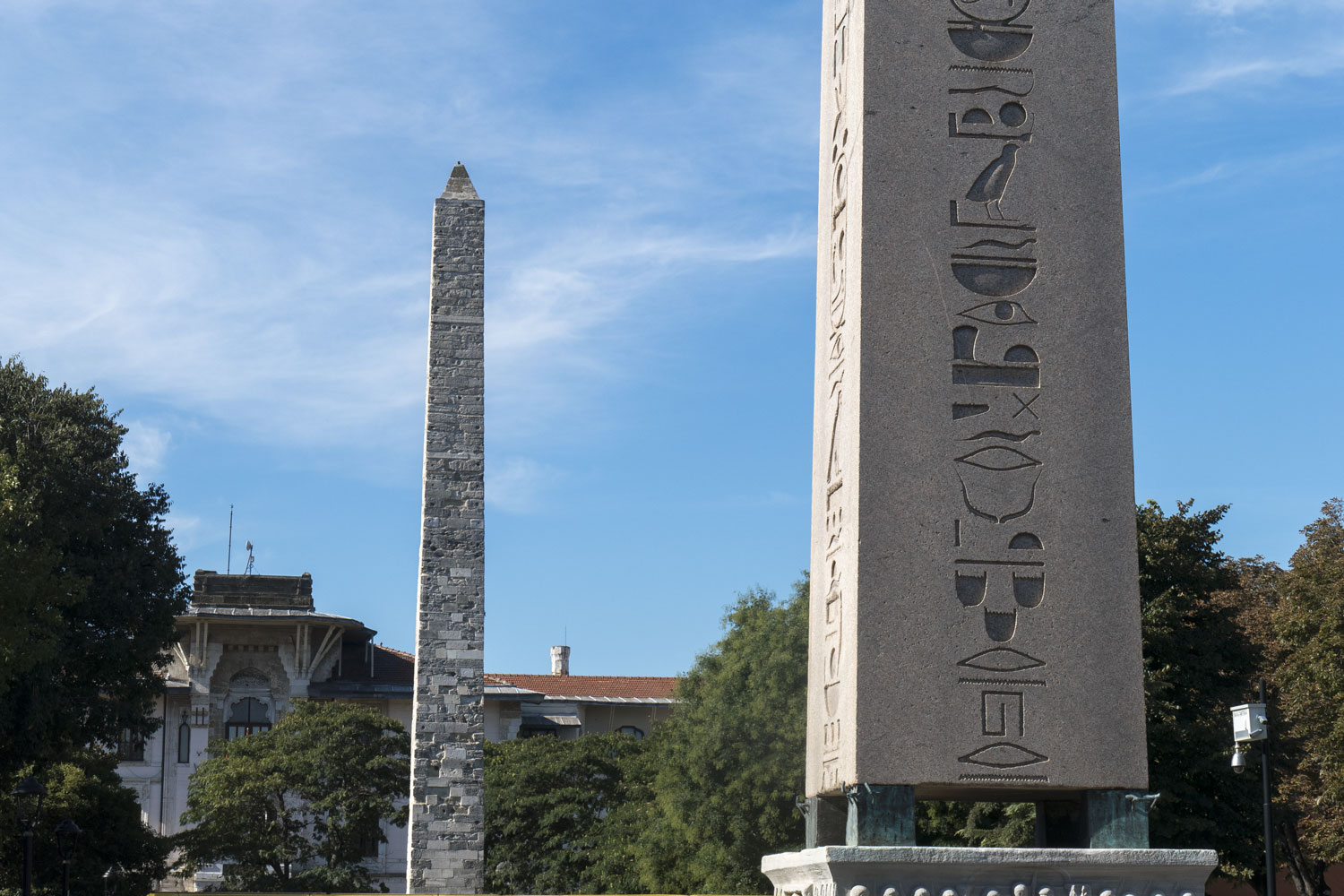
The long Divan Yolu street ascends upwards from Sultanahmet Square.
The word “divan” comes from Persian language. Originally, it meant “house of documents” or “archive”. Later, the word was adopted into other languages, including Turkish, and came to mean “government council/assembly”. Even later, the word made its way into European languages, where it began to refer to a piece of furniture on which the government council would meet.
The second word, “yolu” in Ottoman Turkish means “road, street, avenue”. Thus, “Divan Yolu” would sound to a Turkish ear the same way as “Parliament Street” would sound to an English ear.
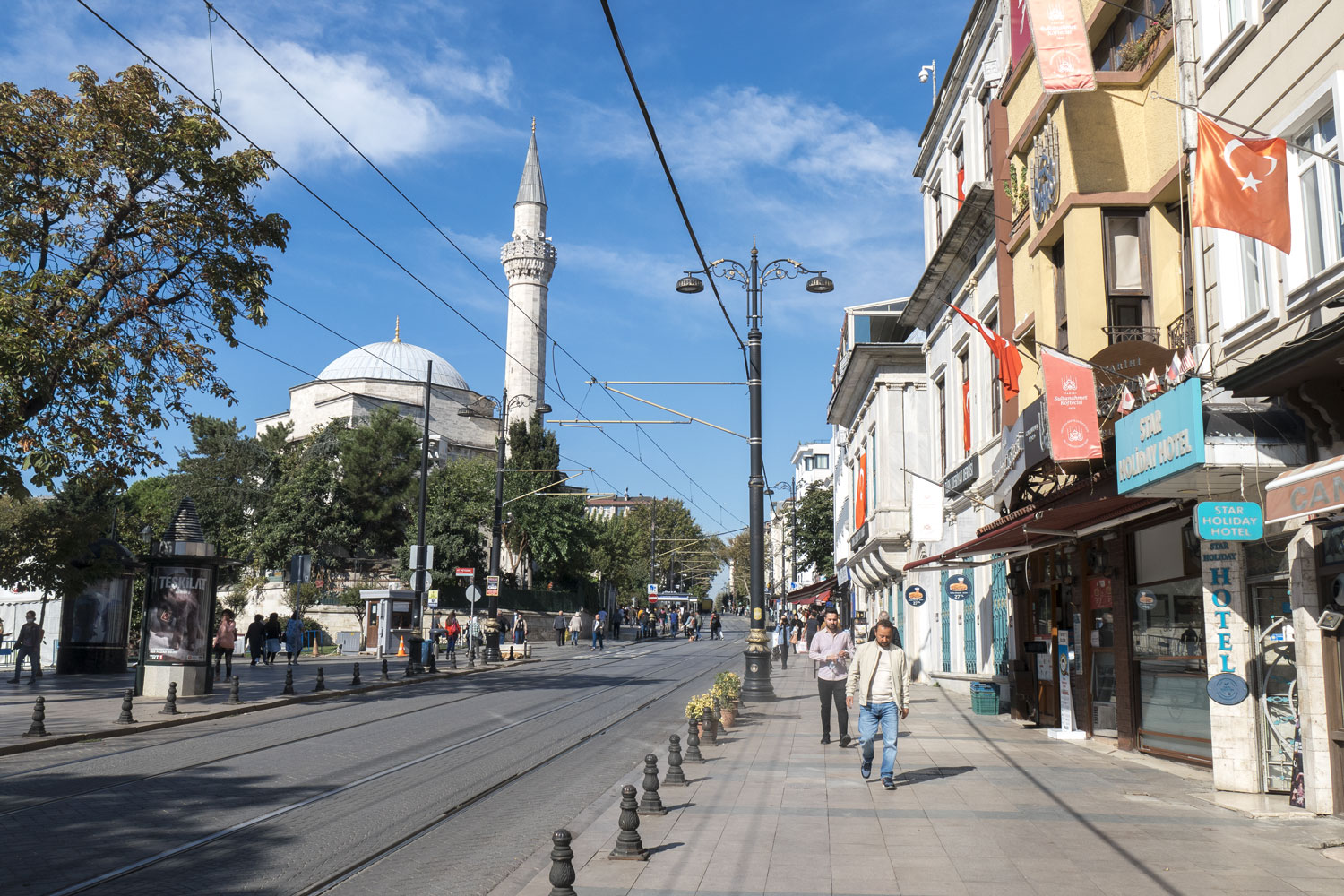
Modern trams run along Parliament Street.
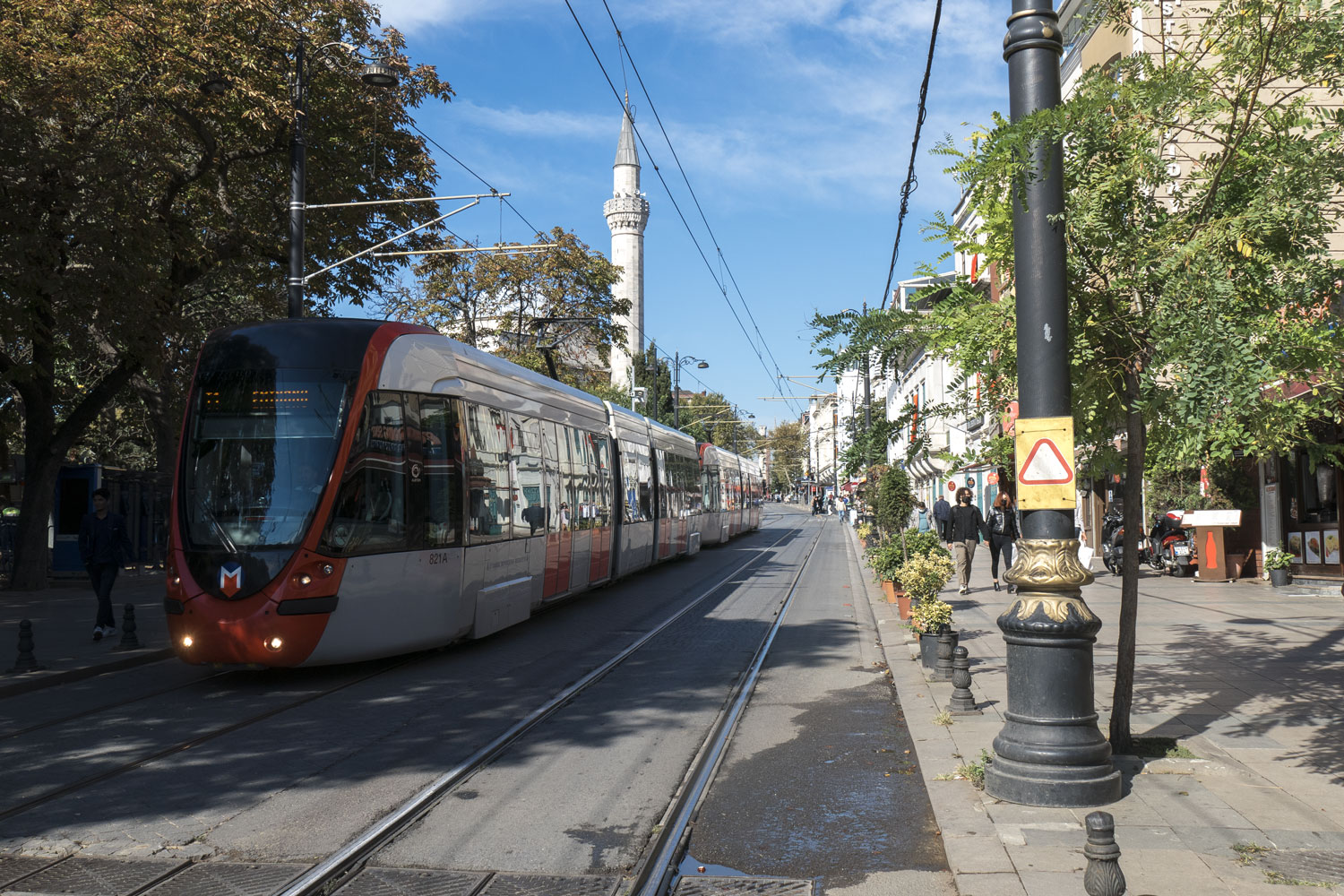
Parliament Street is the most touristy street in Istanbul. Cafes, restaurants, kebab stands, ice cream vendors, shoe stores, pastry shops, museums, and mosques line its entire length.
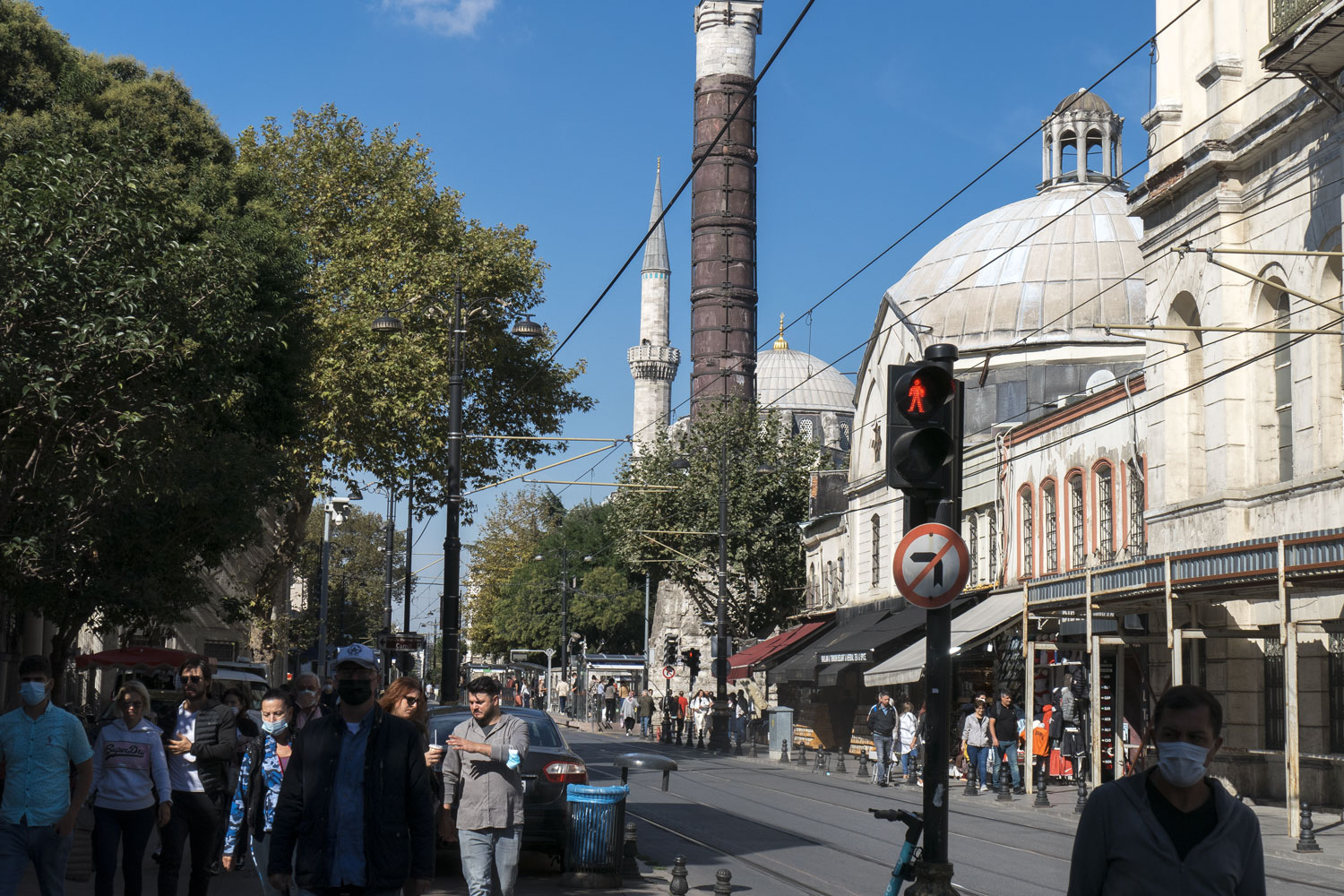
Although a modern tram runs along Parliament Street, when there is no tram, all sorts of carriages and hand carts roll out onto the tracks. Loaders who serve the endless shops along the street are forced to carry goods back and forth on their backs all day long, like slaves in the Roman Empire.
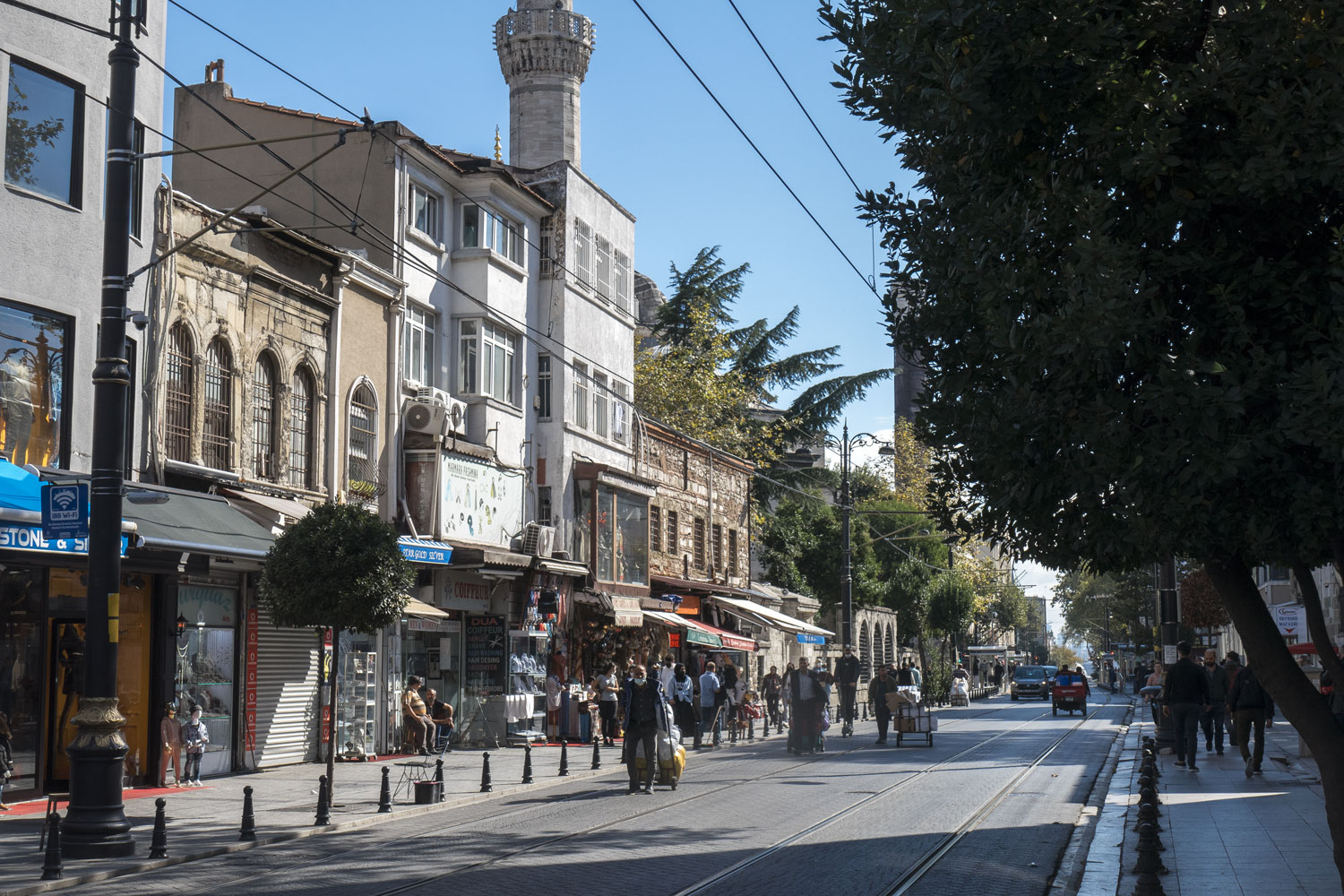
Small streets and alleyways branch out from Parliament Street in both directions like vessels from an artery, leading somewhere downhill. If you walk from Sultanahmet Square, the Grand Bazaar is on your right, while to your left through a narrow gap of straight alleys, a grand expanse of water can be seen.
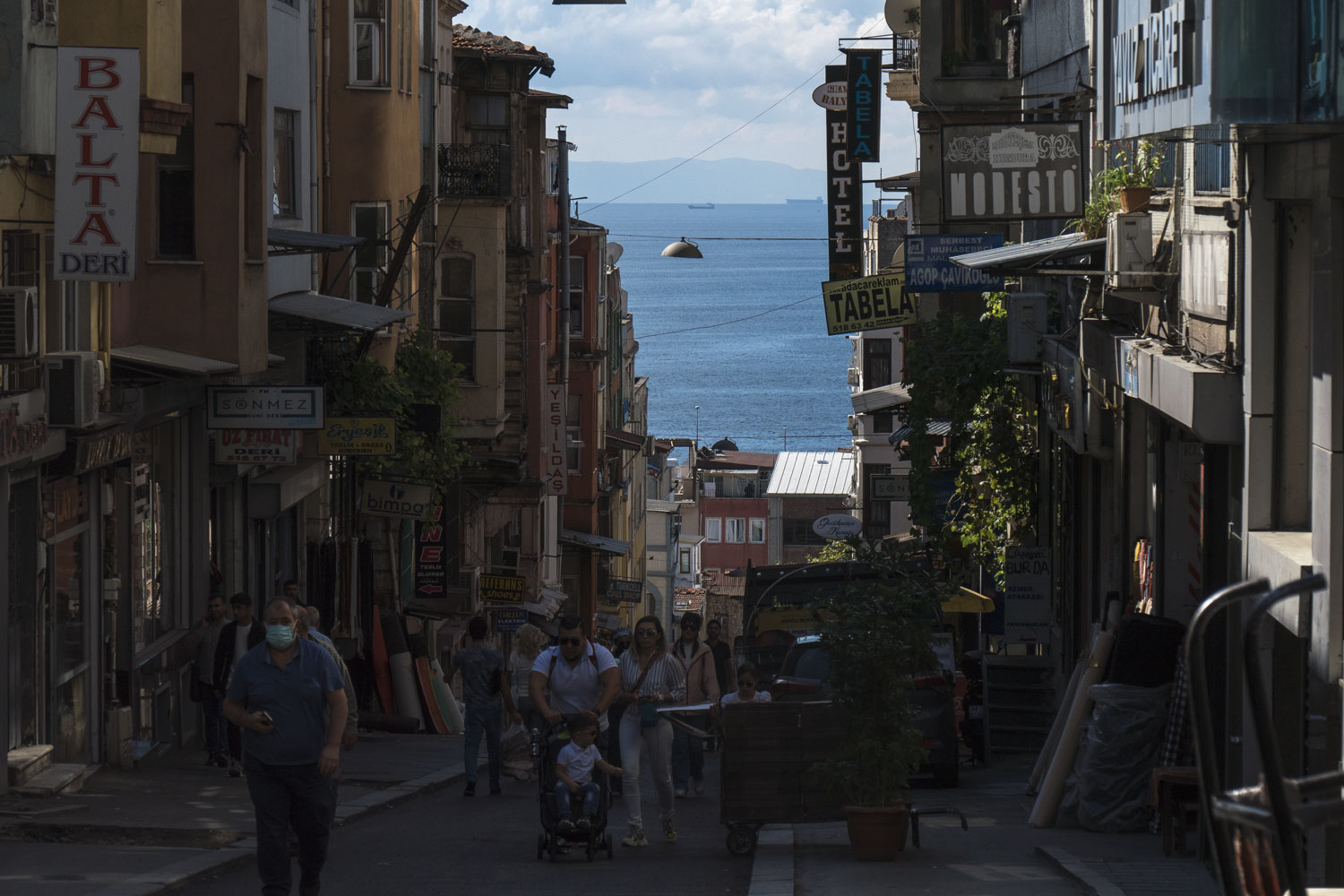
It’s not the Bosphorus. It is behind us. We see the Sea of Marmara, which should actually be called the Sea of Marble, as its islands are rich with marble.
Countless cargo ships ply the waters of the Sea of Marmara, traveling from the Mediterranean to the Black Sea through the Bosphorus Strait and back. Because the streets sharply descend, the ships seem to float in the sky, between the windows and wet laundry.
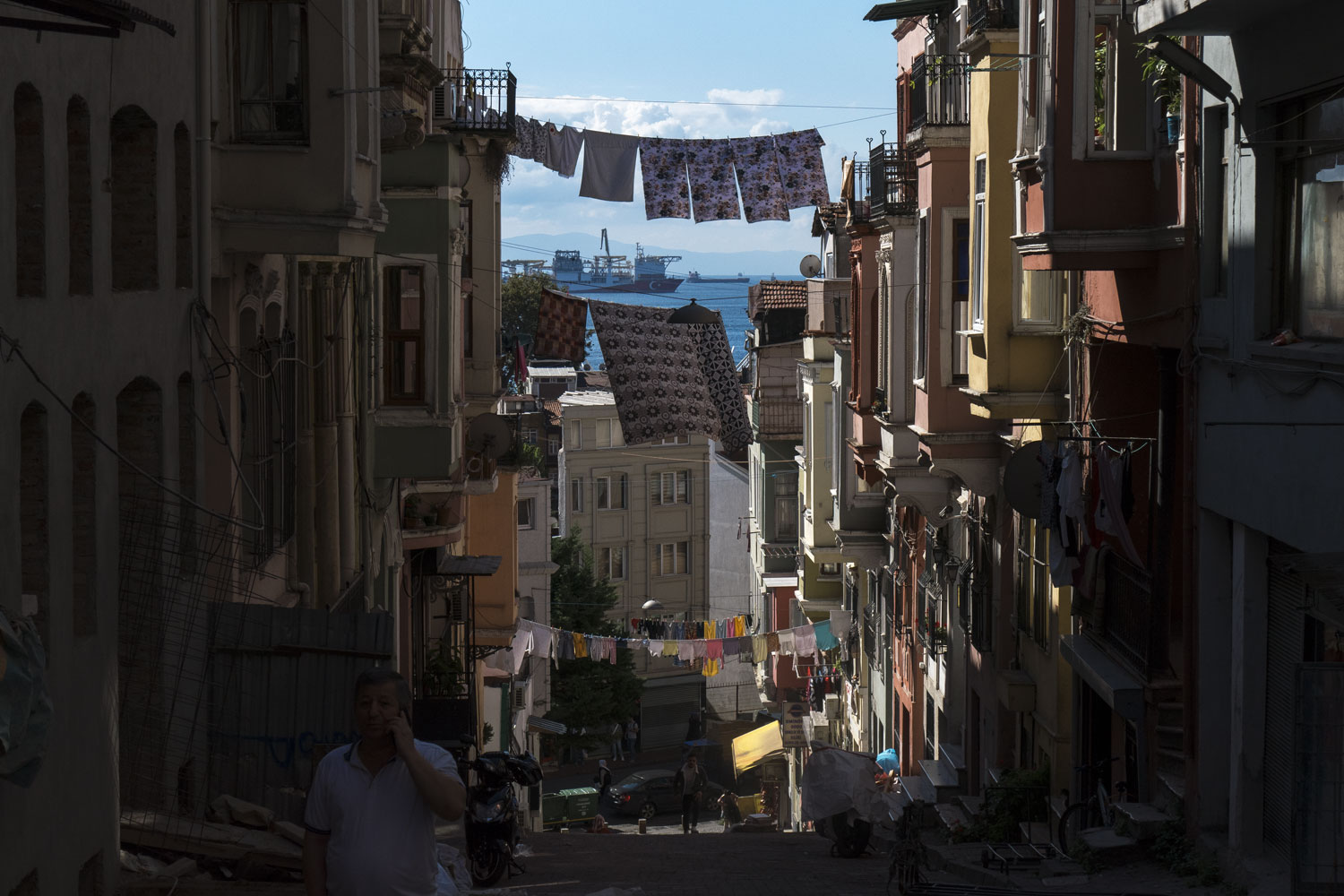
Istanbul is especially beautiful on sunny days with its changes in elevation.
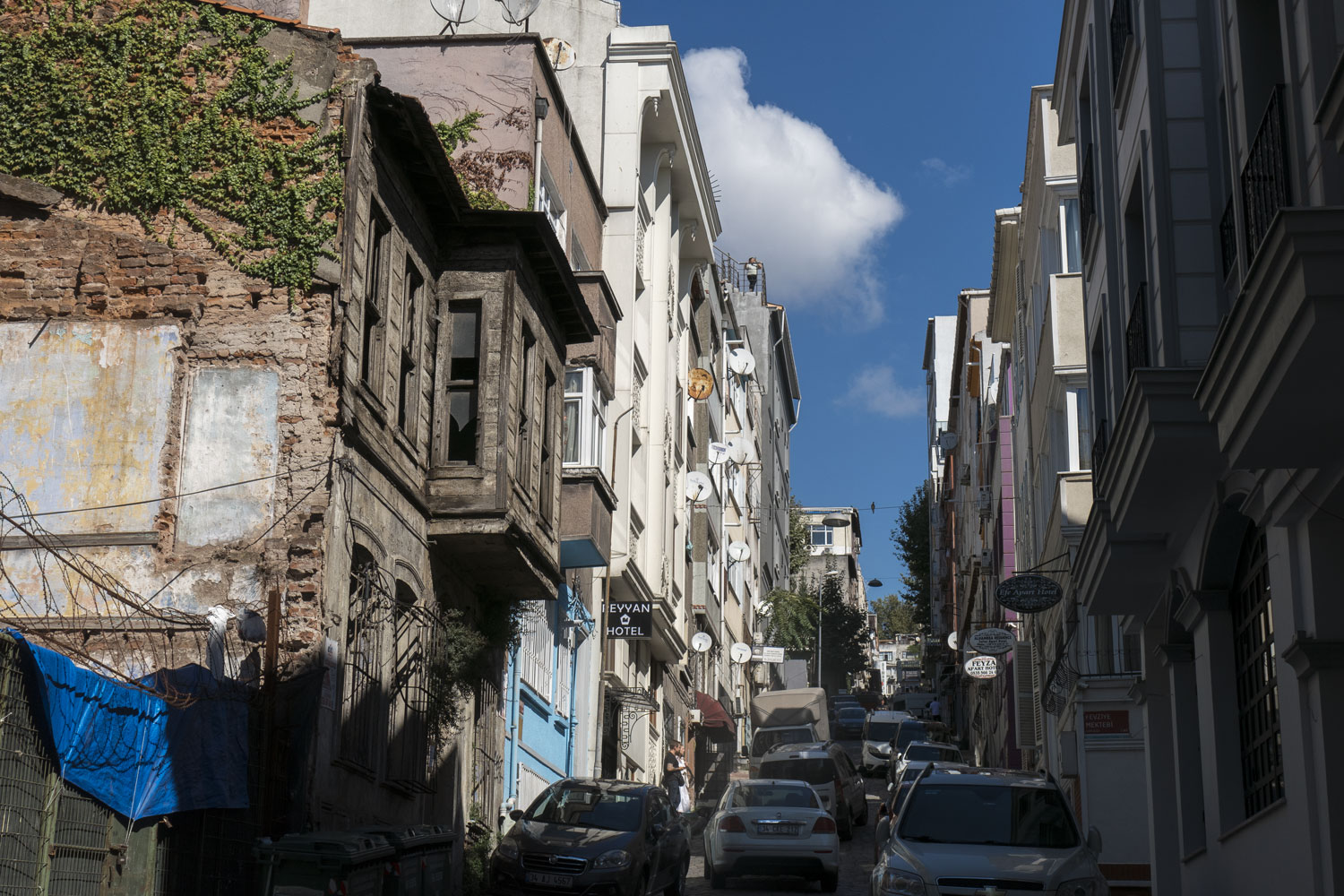
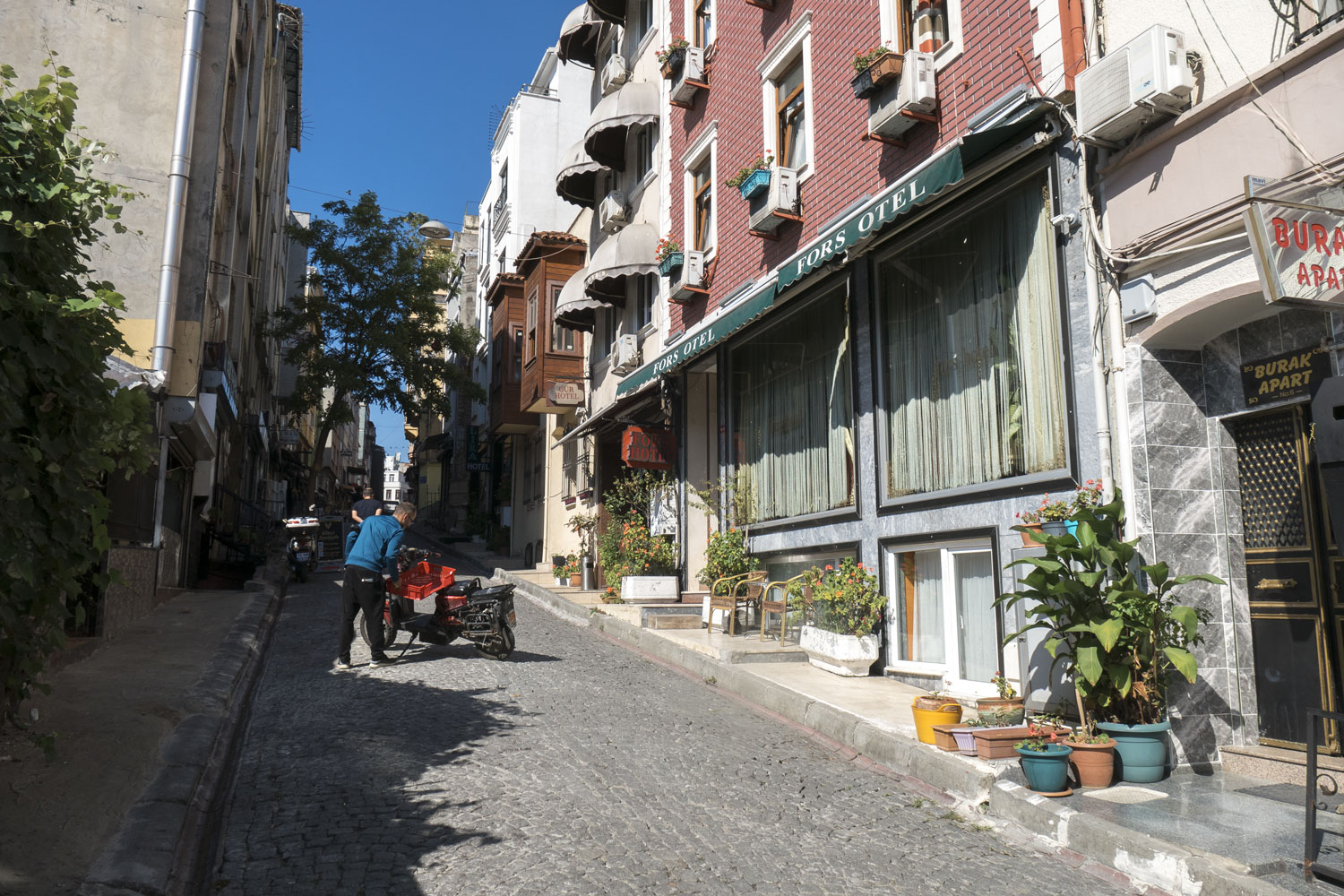
But Istanbul becomes even more beautiful at night, when countless cafes, bazaar stalls and ice cream carts light up with colorful lights. It is then that it becomes clear that Istanbul is the pastry capital of the planet.
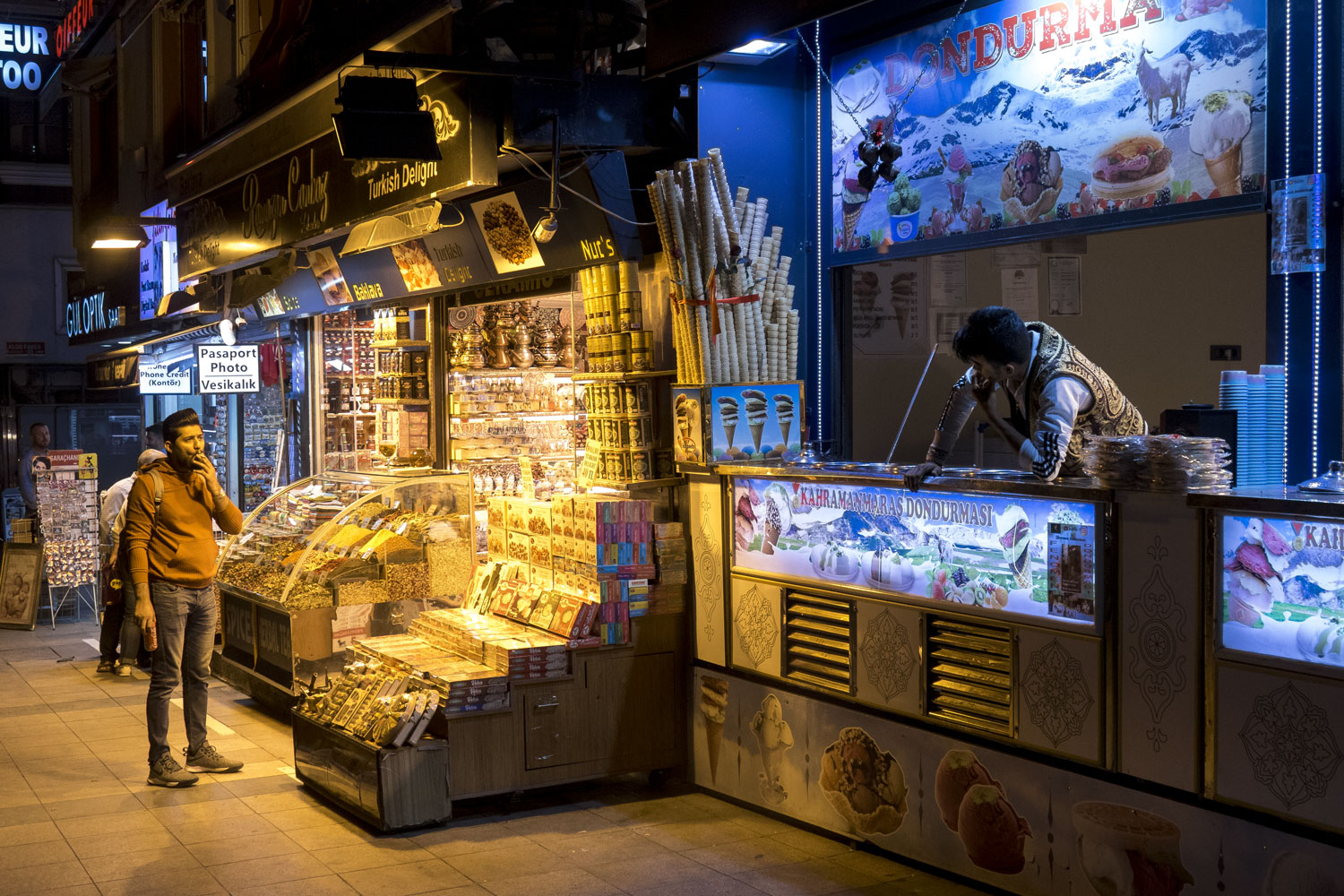
The windows are aglow with a multitude of Turkish baklava. The stores are lit up with warm yellow light, and the sweets in the windows shimmer like gold in a jewelry store.
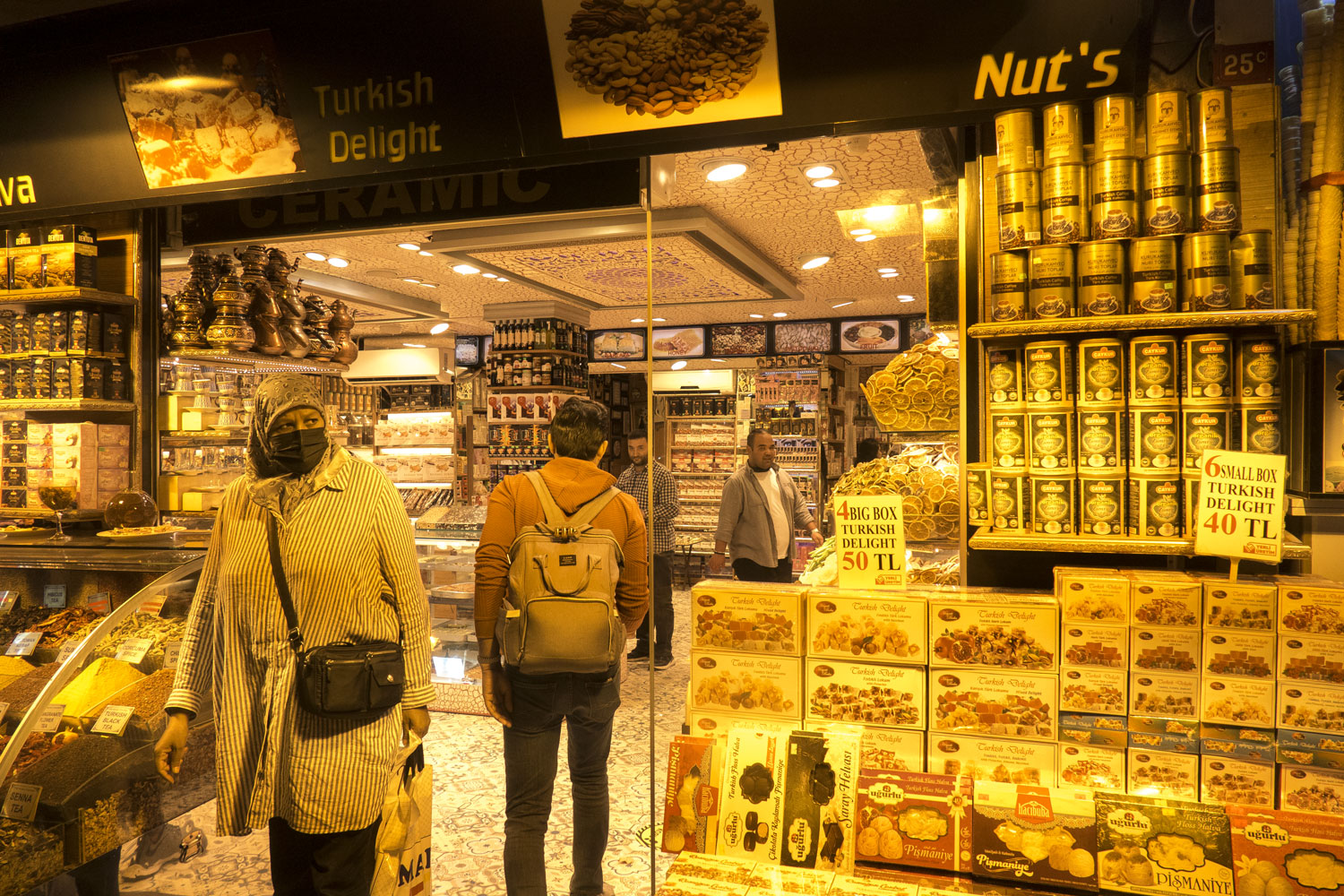
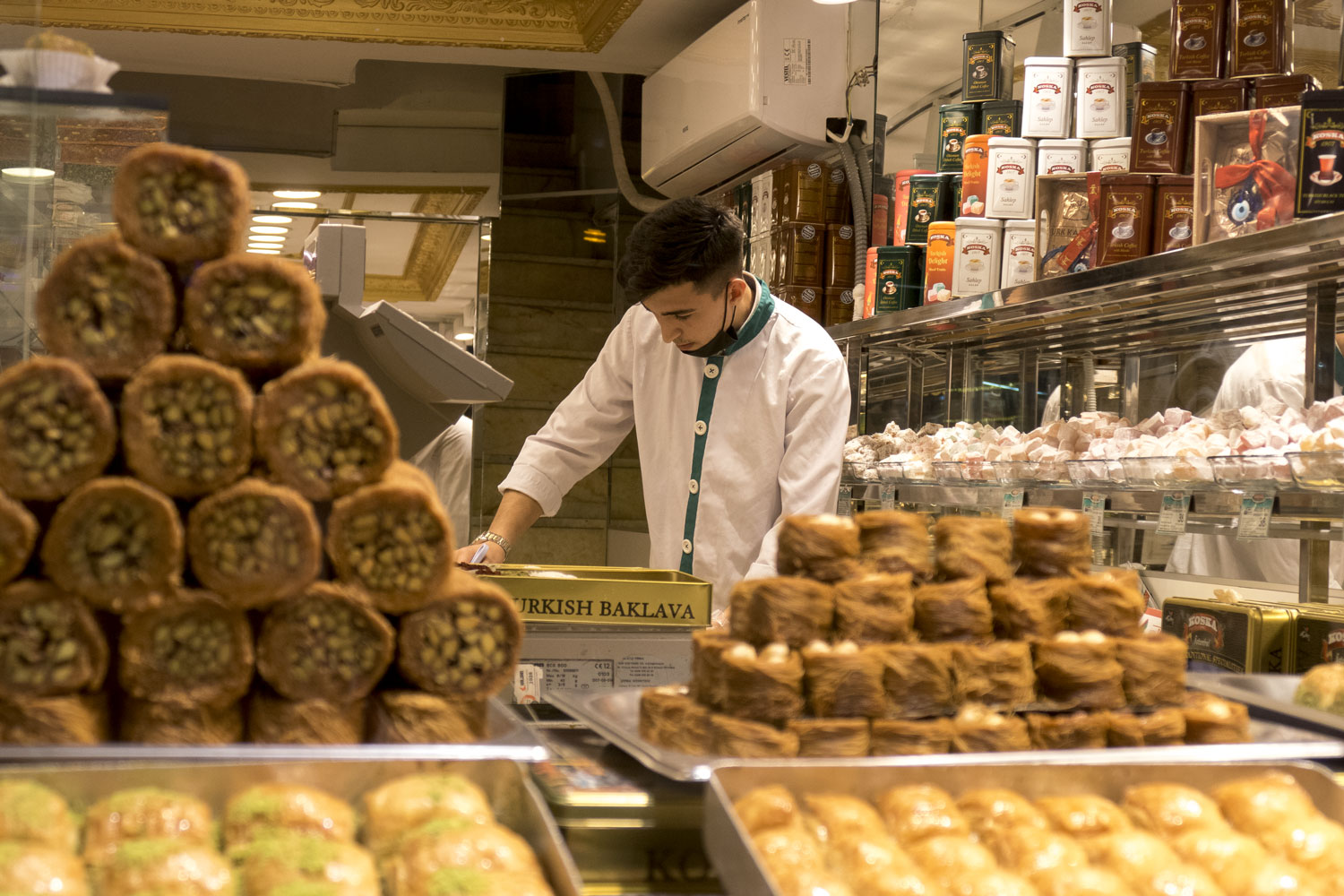
Every evening, tourists and ordinary residents of Istanbul flock to cafes where sweets are served instead of regular dishes. The most desirable cafe in all of Turkey is Hafiz Mustafa with an amazing logo featuring a handsome Turk in traditional clothing and the year it was founded: 1864.
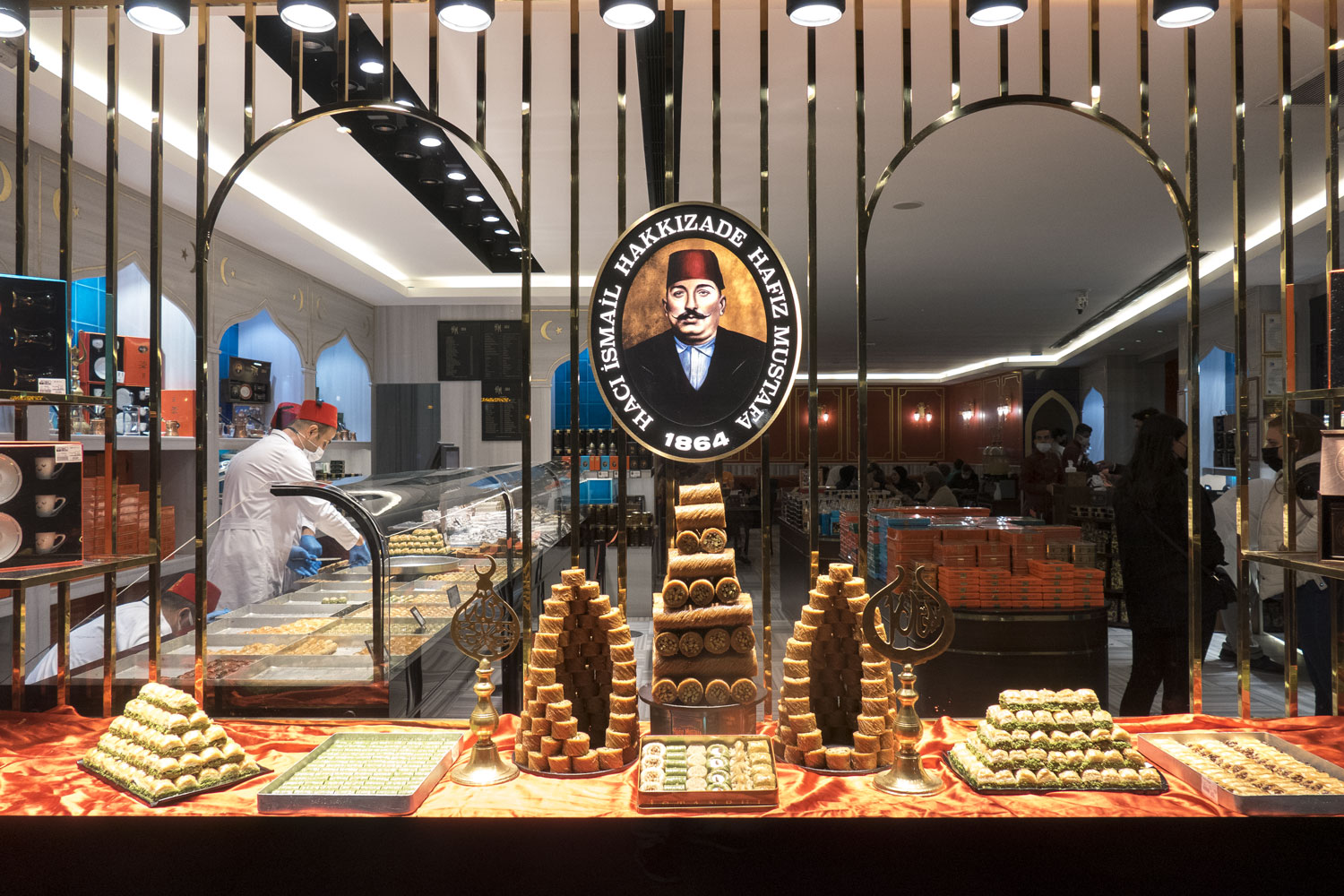
The cafe was founded by Ismail Zade, who previously earned money by lending and lived in Anatolia. Once he decided to conquer the world and went to Istanbul, but his business did not go well here due to tough competition. Therefore, Ismail decided to start his own candy production. His son, Hafiz Mustafa, actually helped him.
Gradually, the business grew, and a full range of sweets was added to the candies: baklava, Turkish delight, pastries, and much more. The confectionery became so successful that Ismail closed his main business. Since then, Hafiz Mustafa cafes have developed into a large chain, won numerous awards, and become the benchmark for Turkish sweets.
The cafes work like this: you enter, sit at a table, and a waiter in traditional clothing appears with the thick menu in seconds. It looks like a regular restaurant menu, but instead of steaks and carbonara, all 50 pages are filled with sweets.
What isn’t here! The dishes served at Hafiz Mustafa’s are not sweets. These are sweet dishes. They are more like salads and stews than cakes and pastries.
One of the most divine dishes is kunefe with ice cream. Kunefe is made from vermicelli and cheese. Soaked in honey, kunefe is laid out on a plate in a circle shape and resembles a well-baked meat cake. On top of it, there is a piece of ice cream sprinkled with green halva — as if fresh spinach was laid on mozzarella cheese.
Kunefe is heated, while the ice cream is cold. The dish melts in your mouth. The honey flavor of warm kunefe mixes with the milky and vanilla notes of the cool, melted ice cream. The complex texture, resembling sweet straw drowned in a delicate tiramisu pastry, slightly crunches and immediately dissolves on the tongue. Then comes the halva, resembling pistachio powder, and a sip of rich Turkish coffee.
Eyes roll up with pleasure. I haven’t eaten anything like this anywhere else in the world. This alone is worth coming to Istanbul — to visit a cafe with this charming Turkish person.
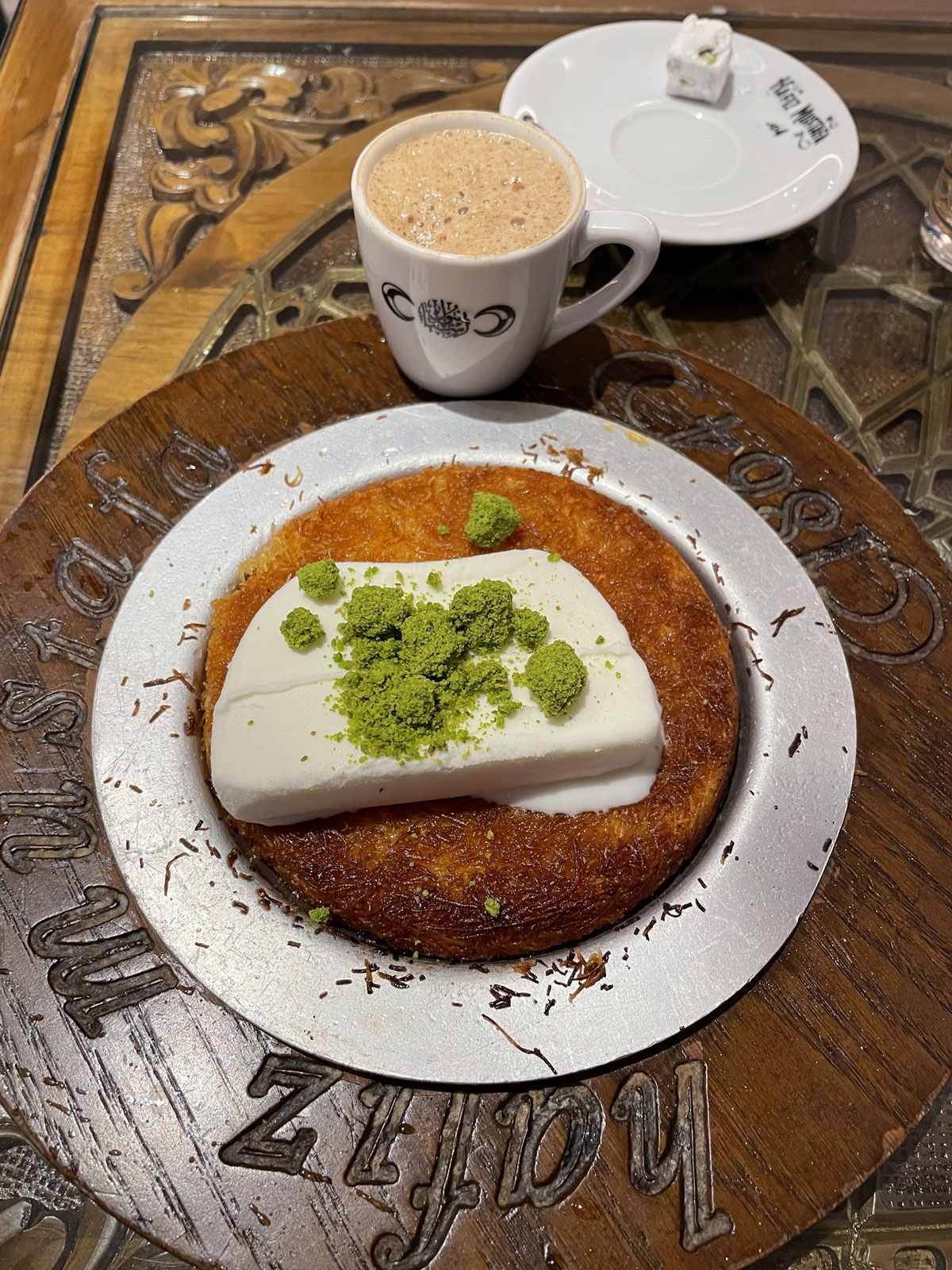
There are simpler establishments to eat at.
One of the most popular street shows in Istanbul is the ice cream magician. You’ve probably seen it before. The seller hands over the ice cream. As soon as the buyer tries to take it, the seller skillfully moves the ice cream away. The trick is repeated with different maneuvers and tricks until the client loses their temper.
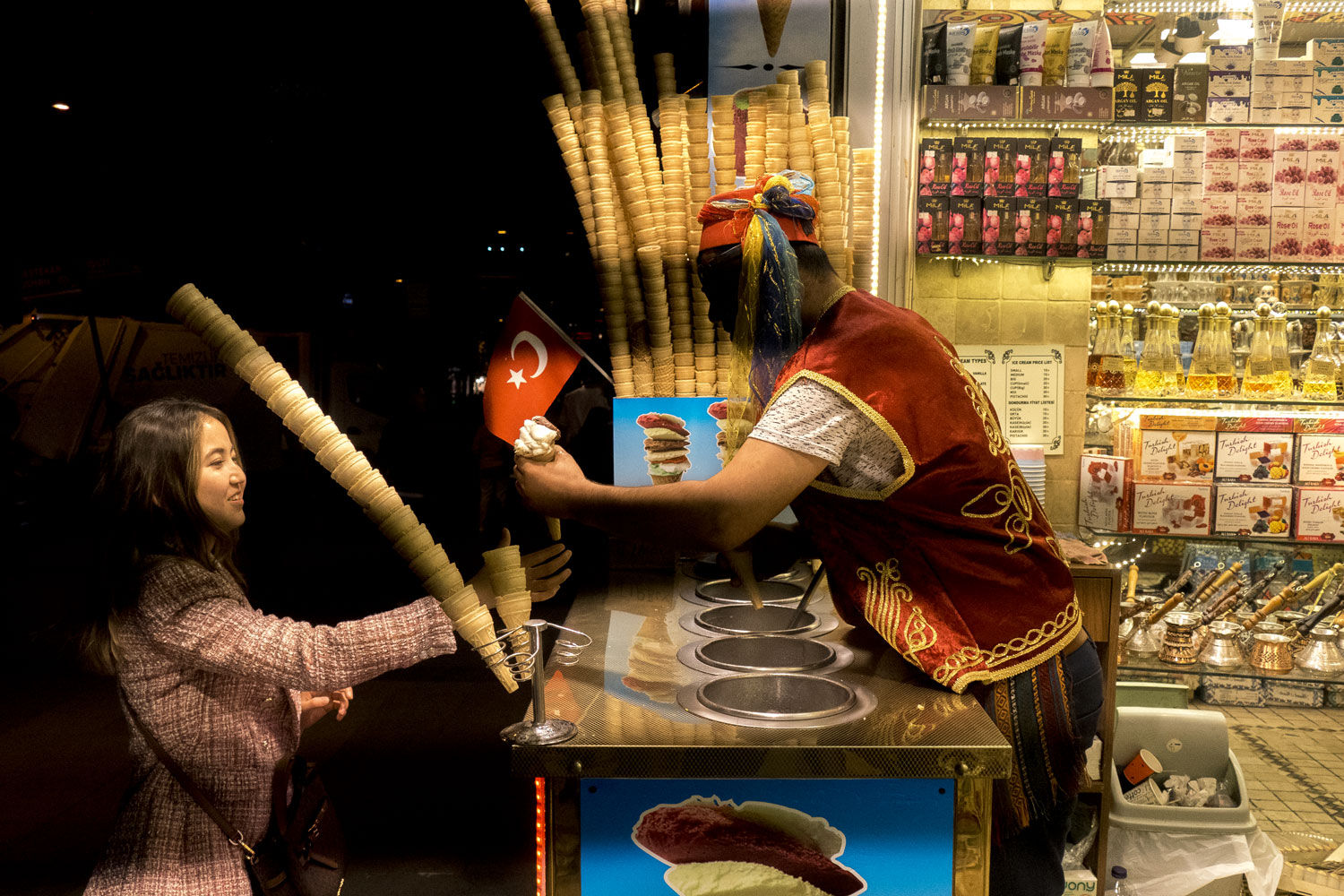
Well, that’s enough eating.
Shoe store. There is so much footwear that the merchant is simply drowning in the background. This is not all the shoes in the store. The entrance to the main part is behind the seller, and the photo shows only the storefront. There are hundreds of such stores in Istanbul, just like pastry shops.
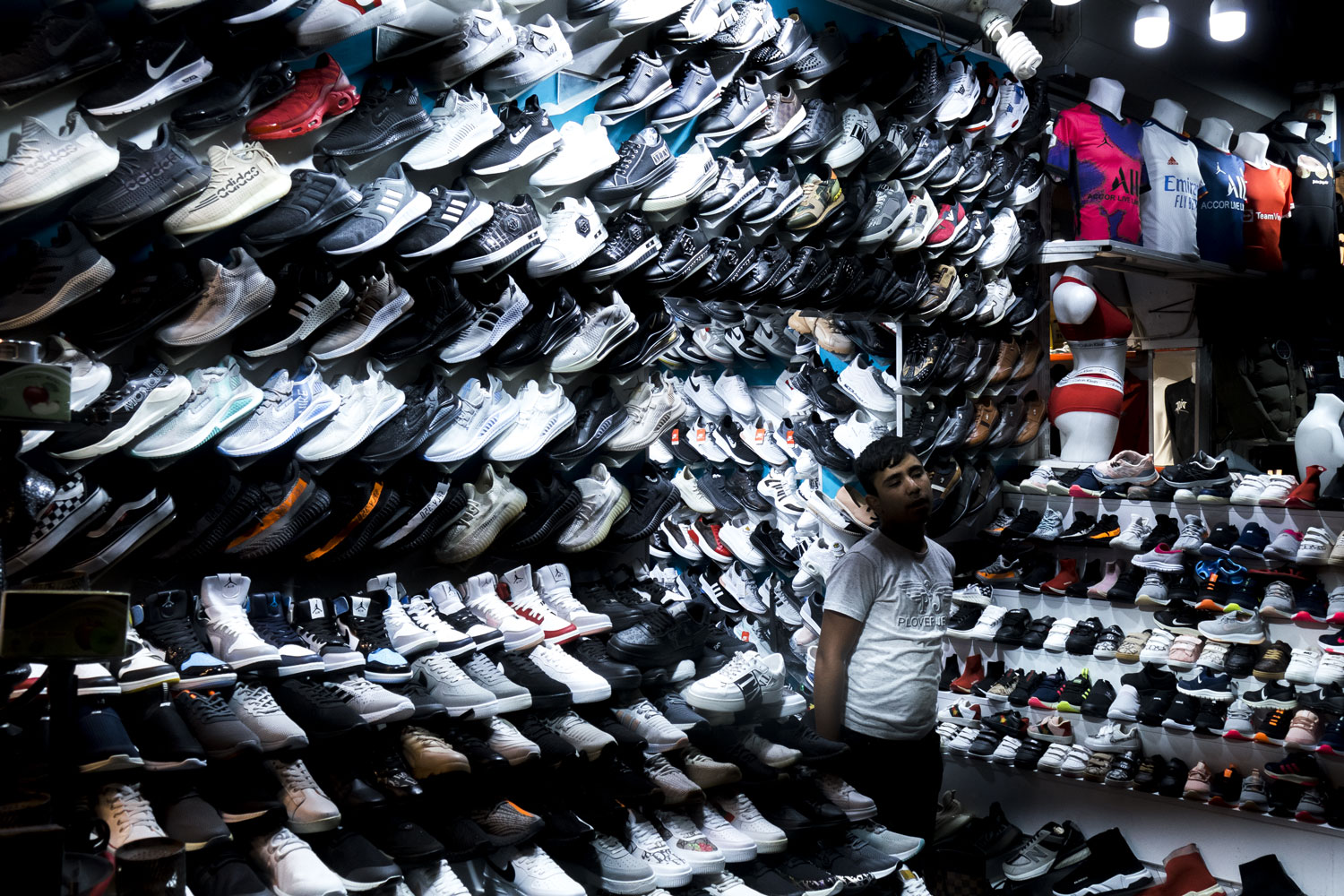
Calligrapher at work. The master sits hunched over a small stool all day and writes Arabic script on plaques.
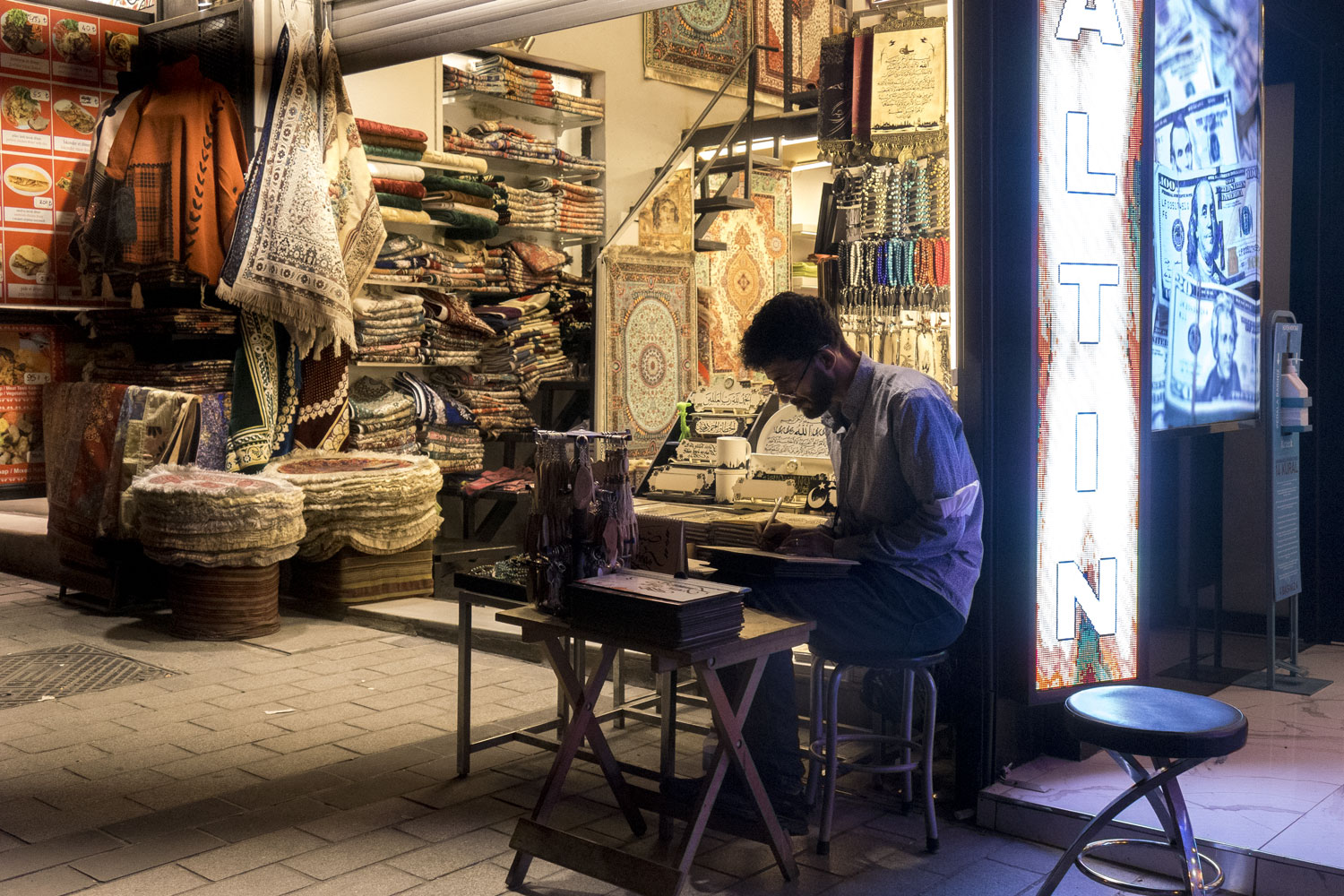
Advertisement for piercing and tattoos. Although drawing on the body is not welcomed in Islam, tattoo culture is well developed in Turkey. In the salon, you can have Arabic script or a scene from Eastern fairy tales inked on your skin.
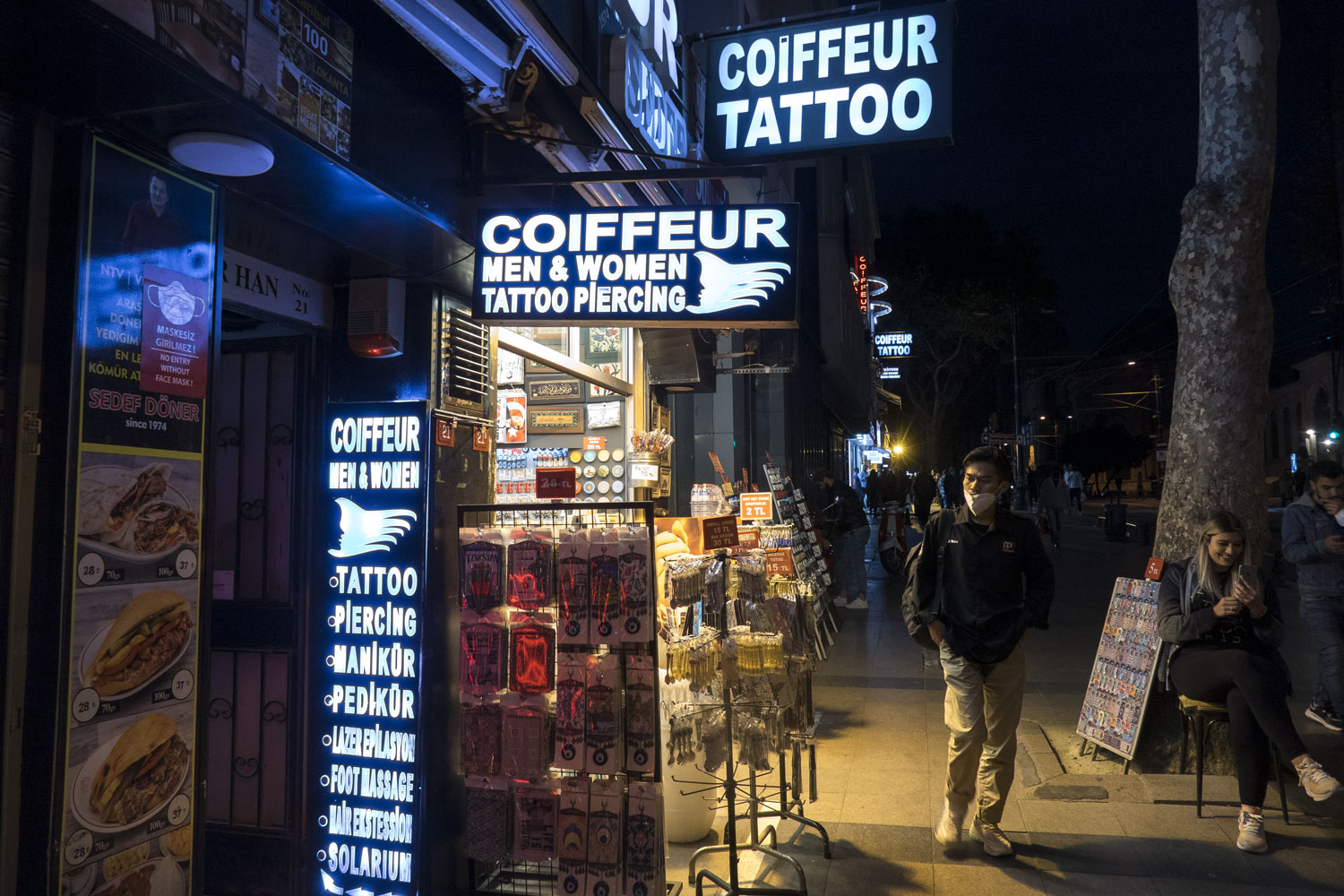
All that was shown above is located in the western part of Istanbul. And there are three of them in total. There is also an eastern and northern part. The Bosphorus Strait separates the eastern part, while the Golden Horn Bay separates the northern part.
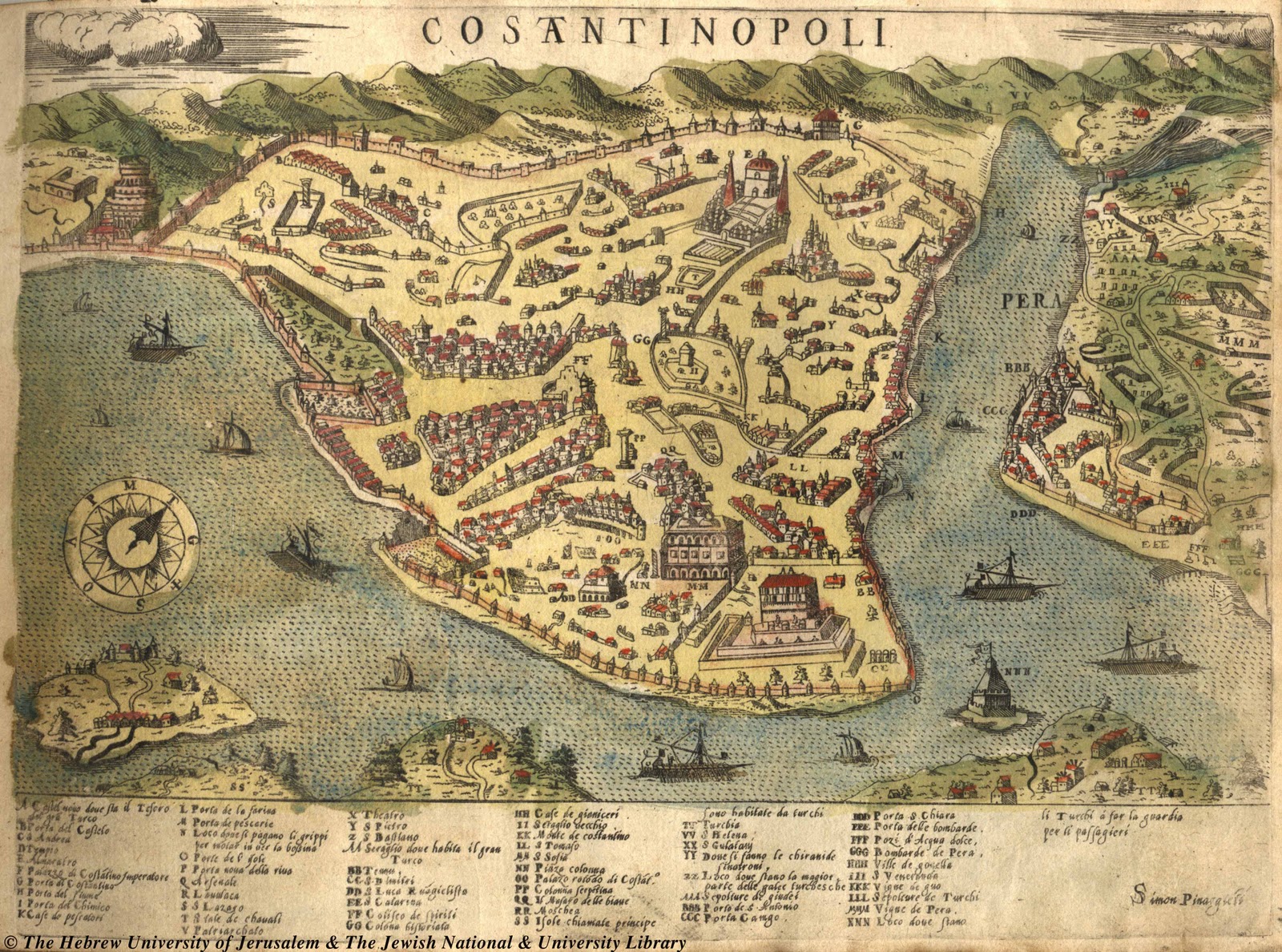
There are not as many attractions in the northern or eastern parts of Istanbul as there are in the western part. That is why Turkey is often regarded as part of Europe: its main capital is located on the European continent.
Fortunately, Istanbul is surrounded by a very good transportation network. The metro is the most convenient way to travel around the city, connecting parts of the city even across the Bosphorus and the Golden Horn Bay.
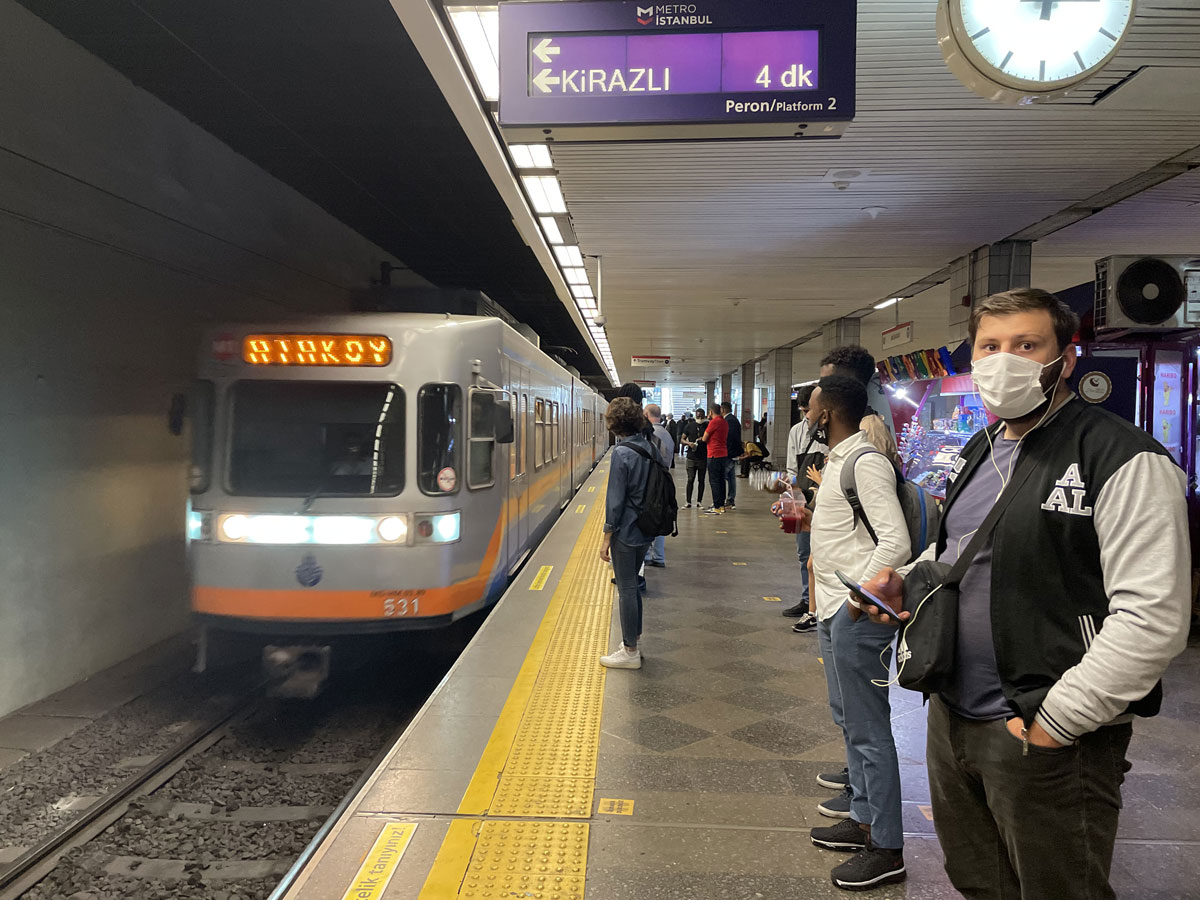
The main landmark in the northern part of Istanbul is the Galata Tower. This tower was built in the mid-14th century and was initially used for defense and as a lighthouse, but later converted into an observatory and viewing platform. It is said that a famous Ottoman inventor once jumped from the tower with homemade wings and even flew some distance.
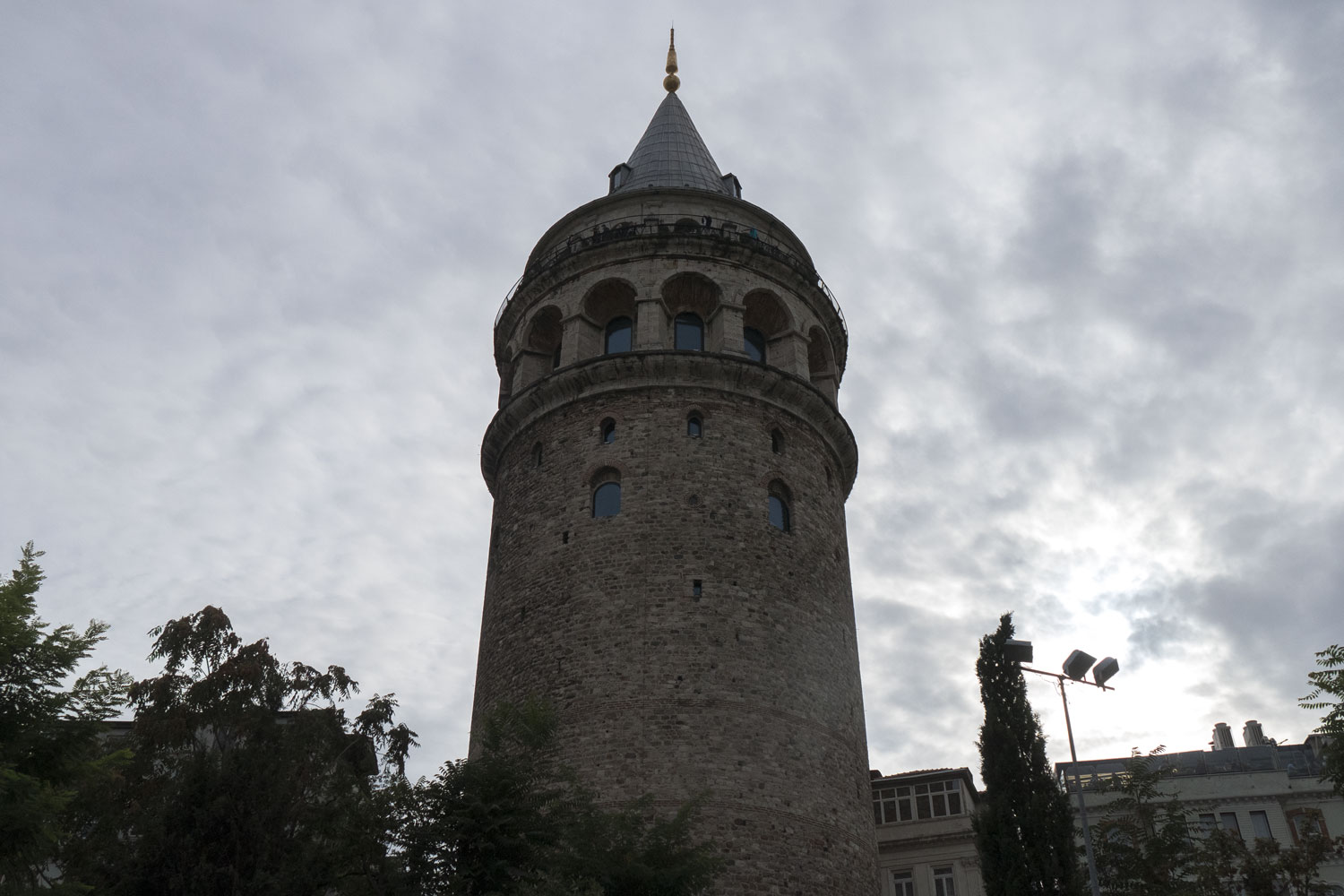
At the foot of the tower, there is a cafe owned by Turkish culinary celebrity, Mr. Nusret Gokce, better known by his nickname Salt Bae.
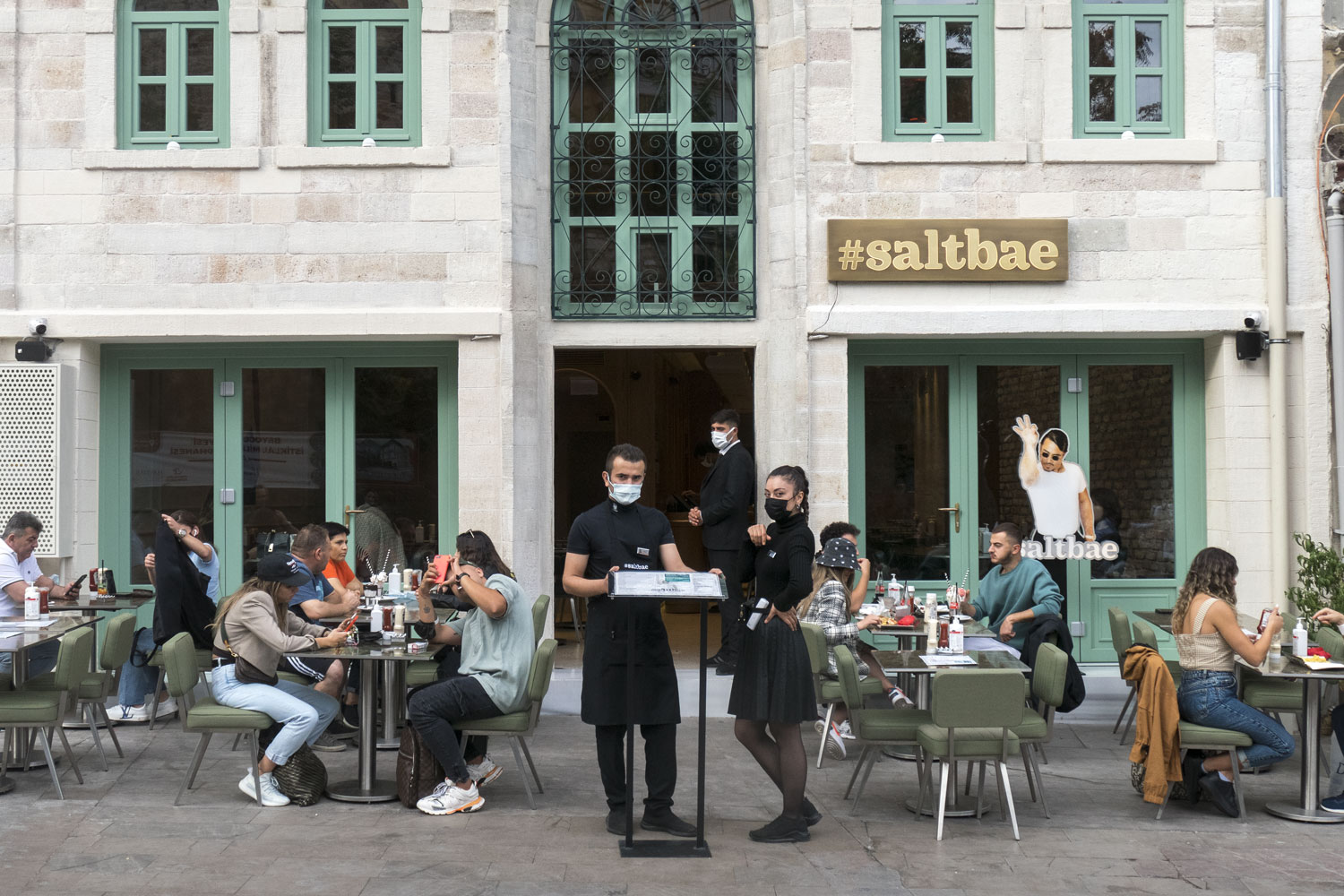
Nusret became famous for elegantly sprinkling juicy meat steaks with salt, rolling large sea salt over his elbow and bending his arm like a snake. Instantly, Salt Bae became an internet meme. Now, calling Nusret to personally sprinkle salt on a steak costs several thousand dollars.
Apart from the tower, a couple of restaurants, and an extremely dull museum of dervishes in the northern part of Istanbul, there is nothing much to do except taking a ride on an antique tram.
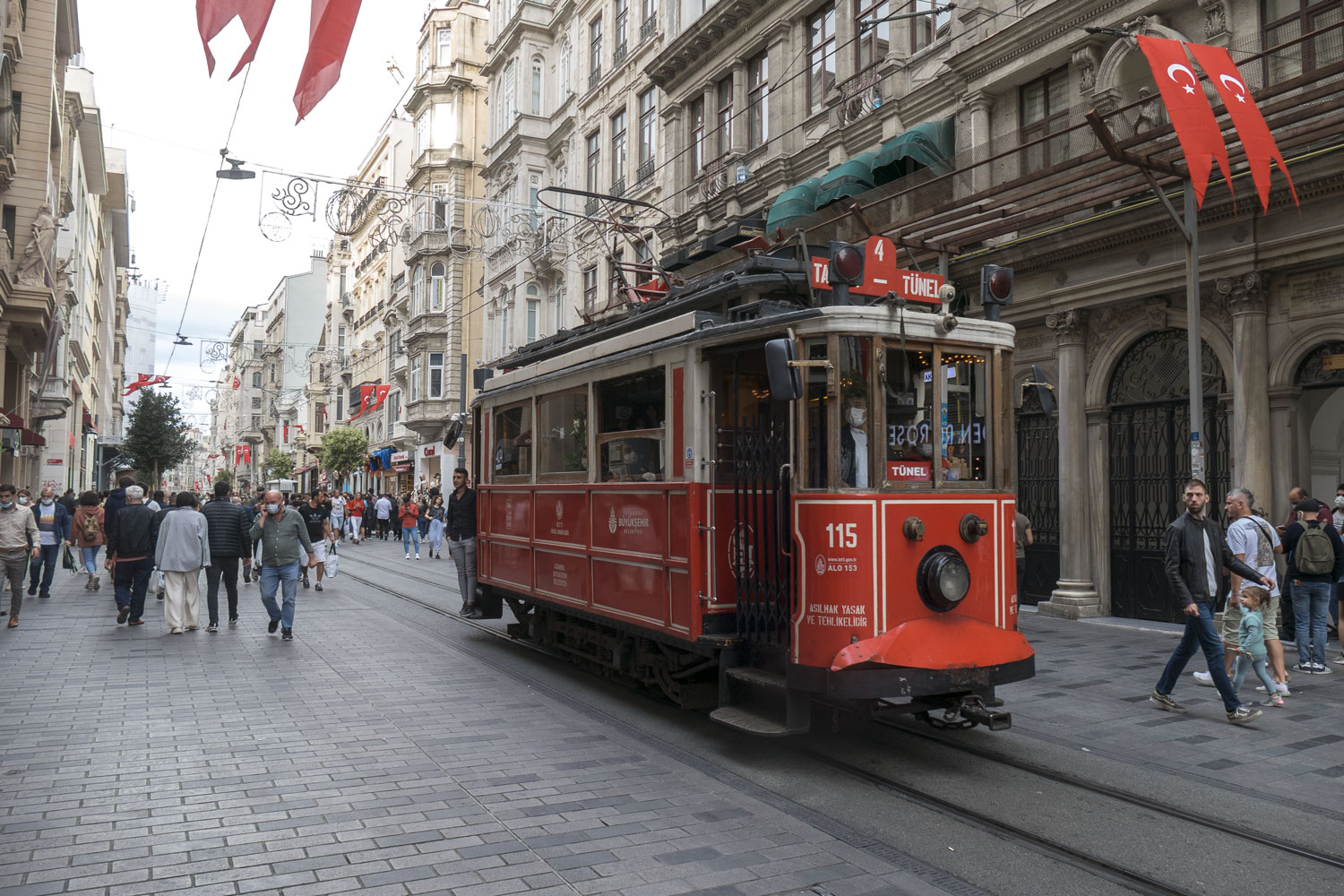
There are no particular points of interest in the eastern part either, but there is an excellent view of the city across the Bosphorus.
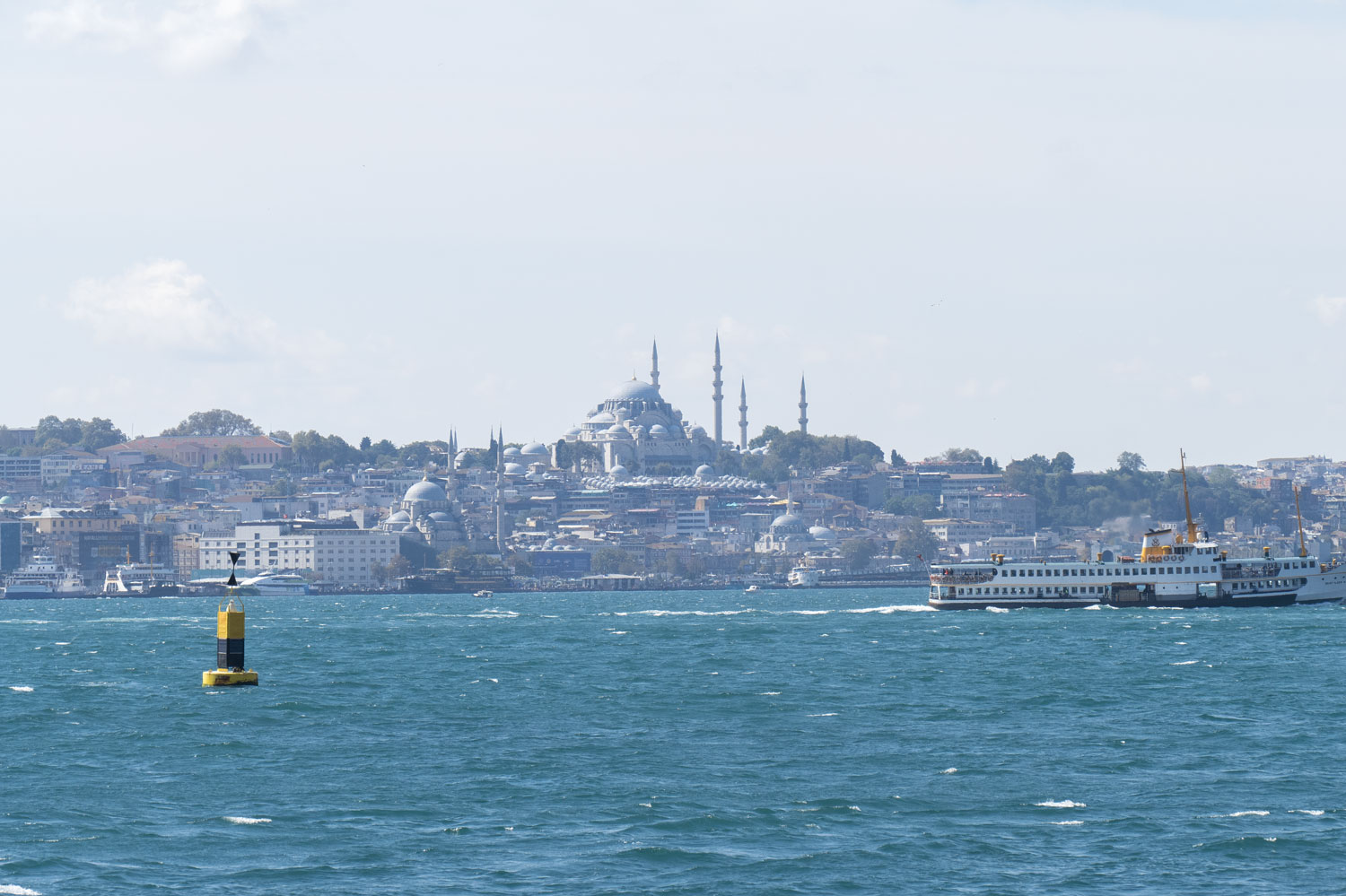
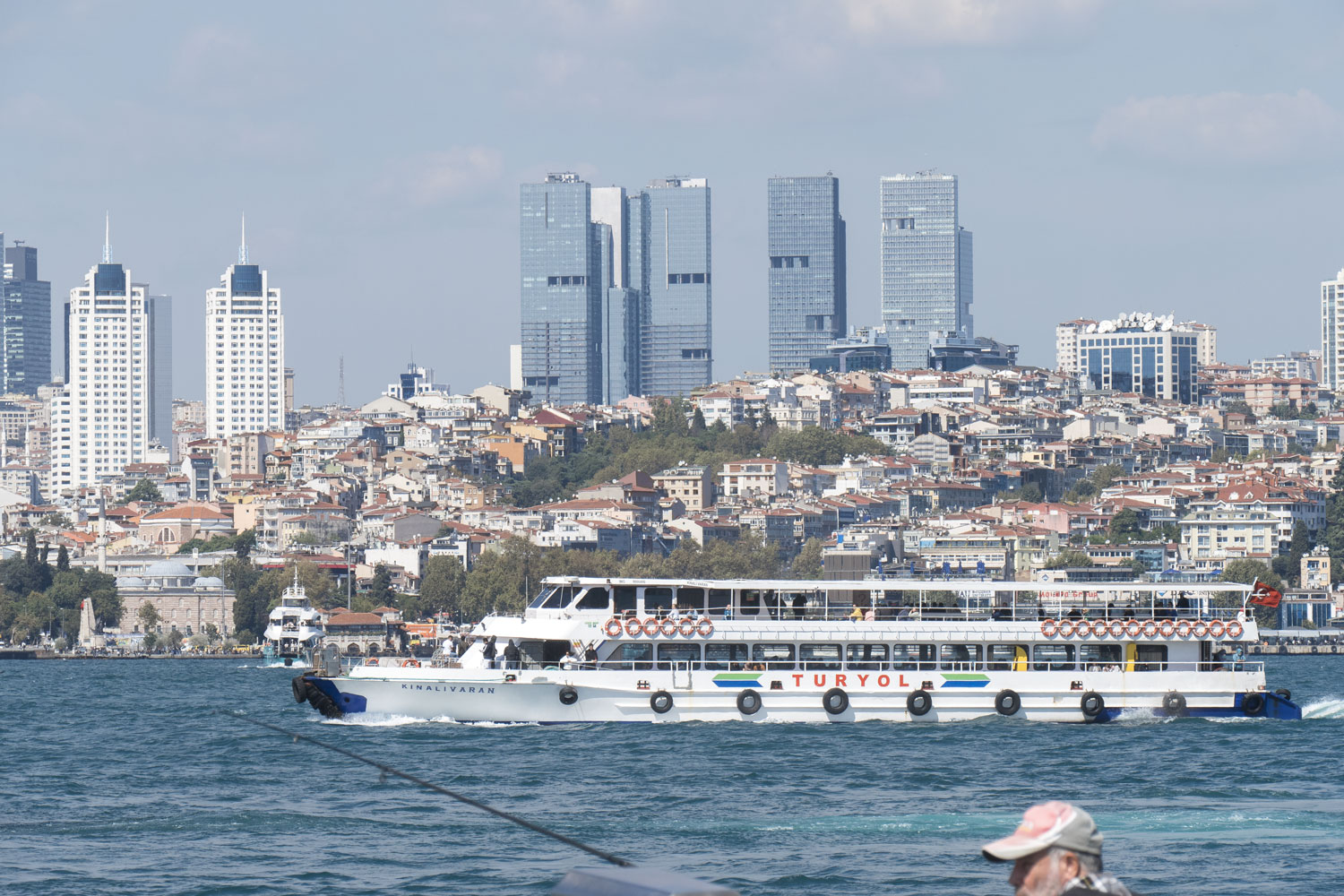
There is a long waterfront promenade where crowds of people walk along the coast. Fishermen everywhere catch fish.
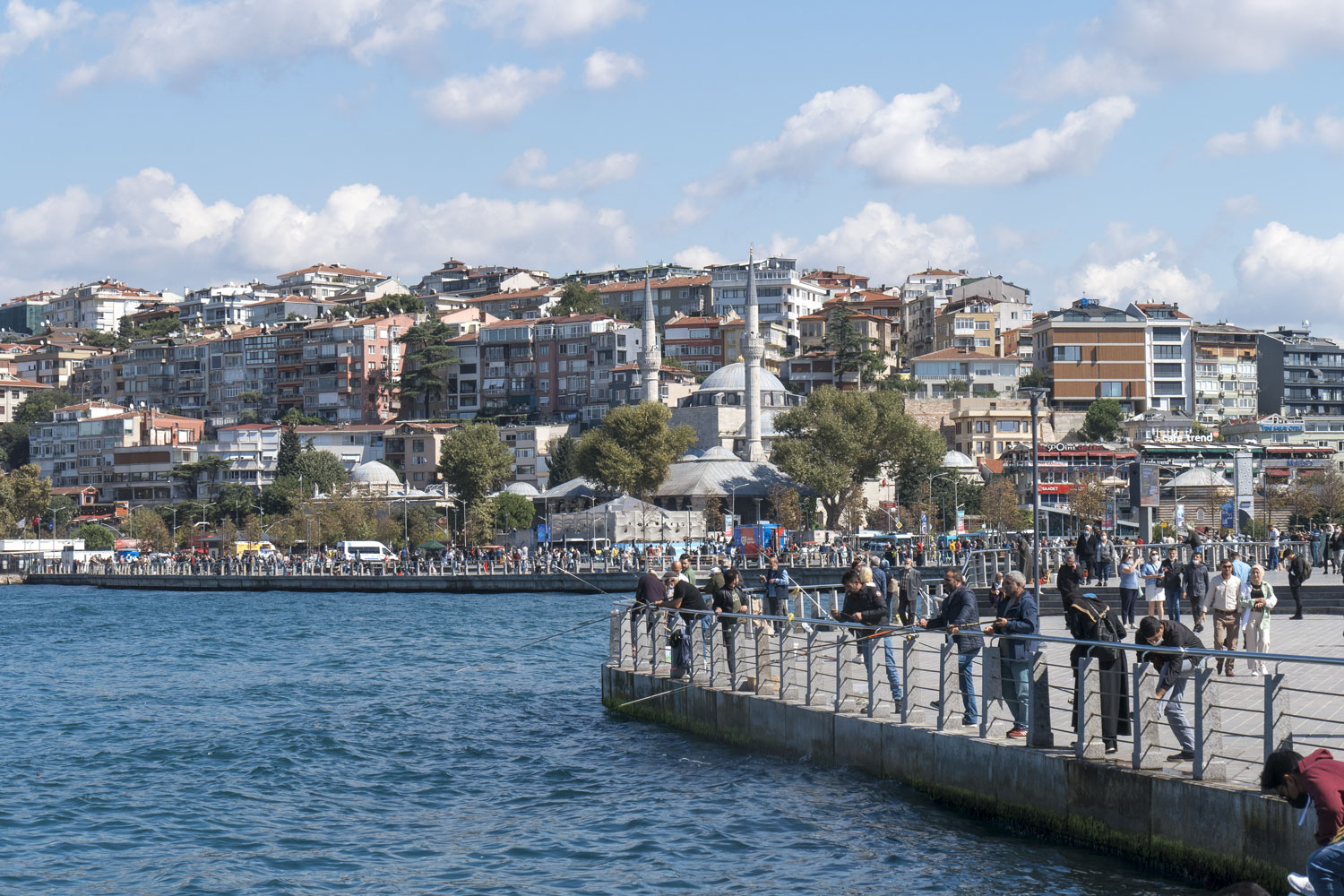
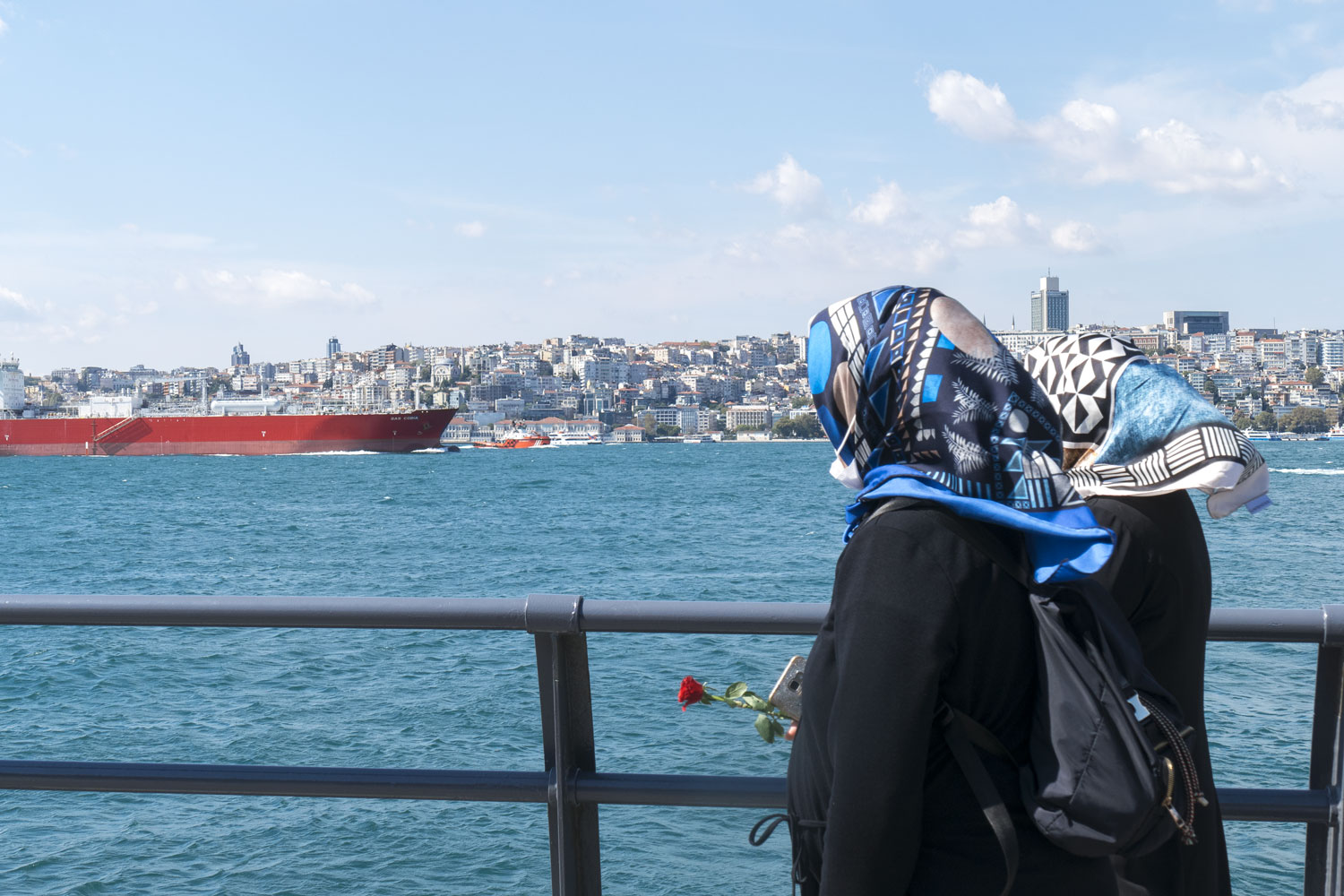
The only point of interest is the Maiden’s Tower, surrounded by many legends about its purpose and history. Nonetheless, there is now a restaurant in the tower, which a small ferry travels to on a schedule.
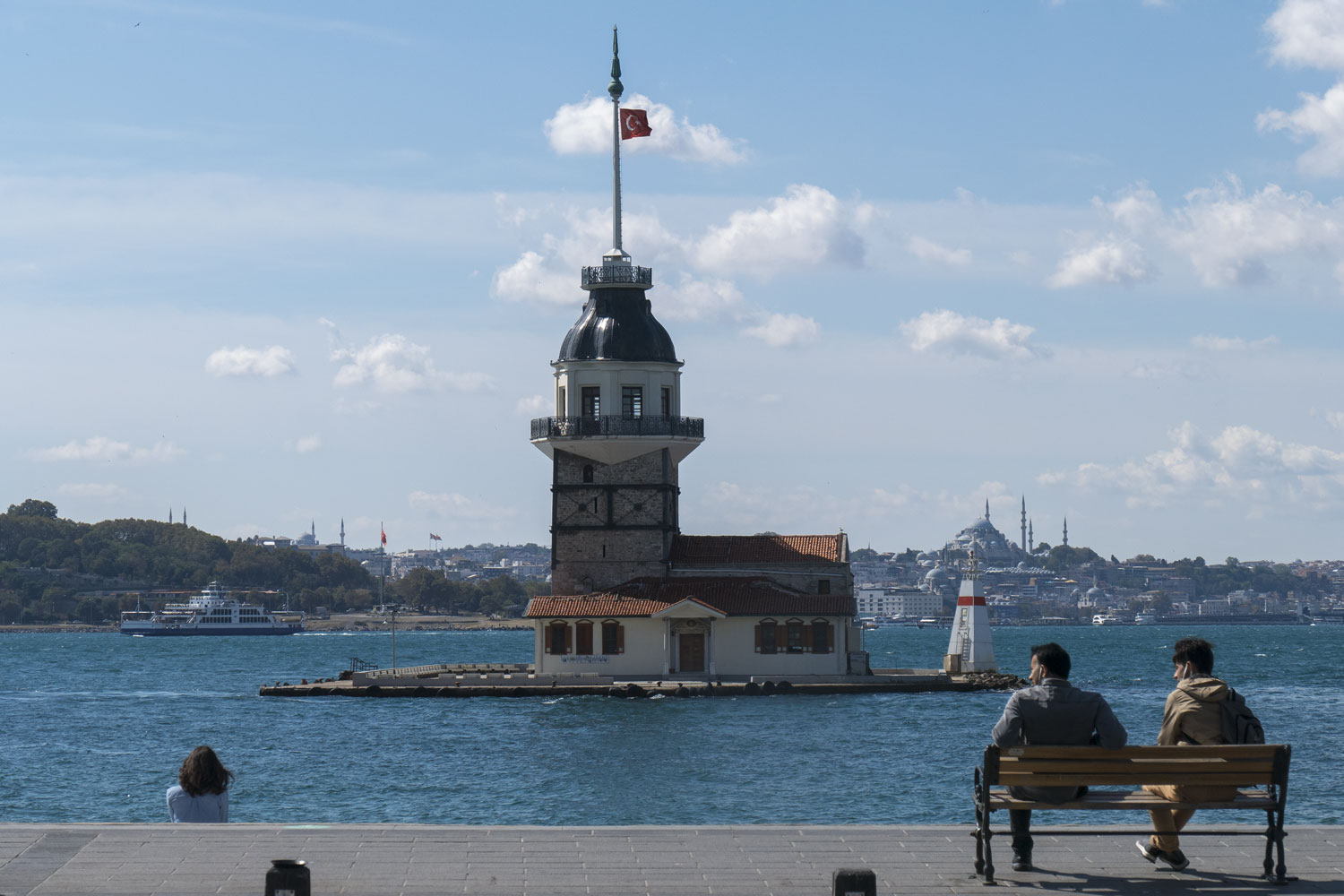
Well, that’s it.
Istanbul is a bit bland and overly large city, but still a great place to start exploring eastern culture, stroll through old bazaars and streets, and indulge in sweets.
It’s better to focus on the historical center. It’s impossible to see the whole city, and it’s unlikely necessary as it has grown too much.
